Nav
Horse Power
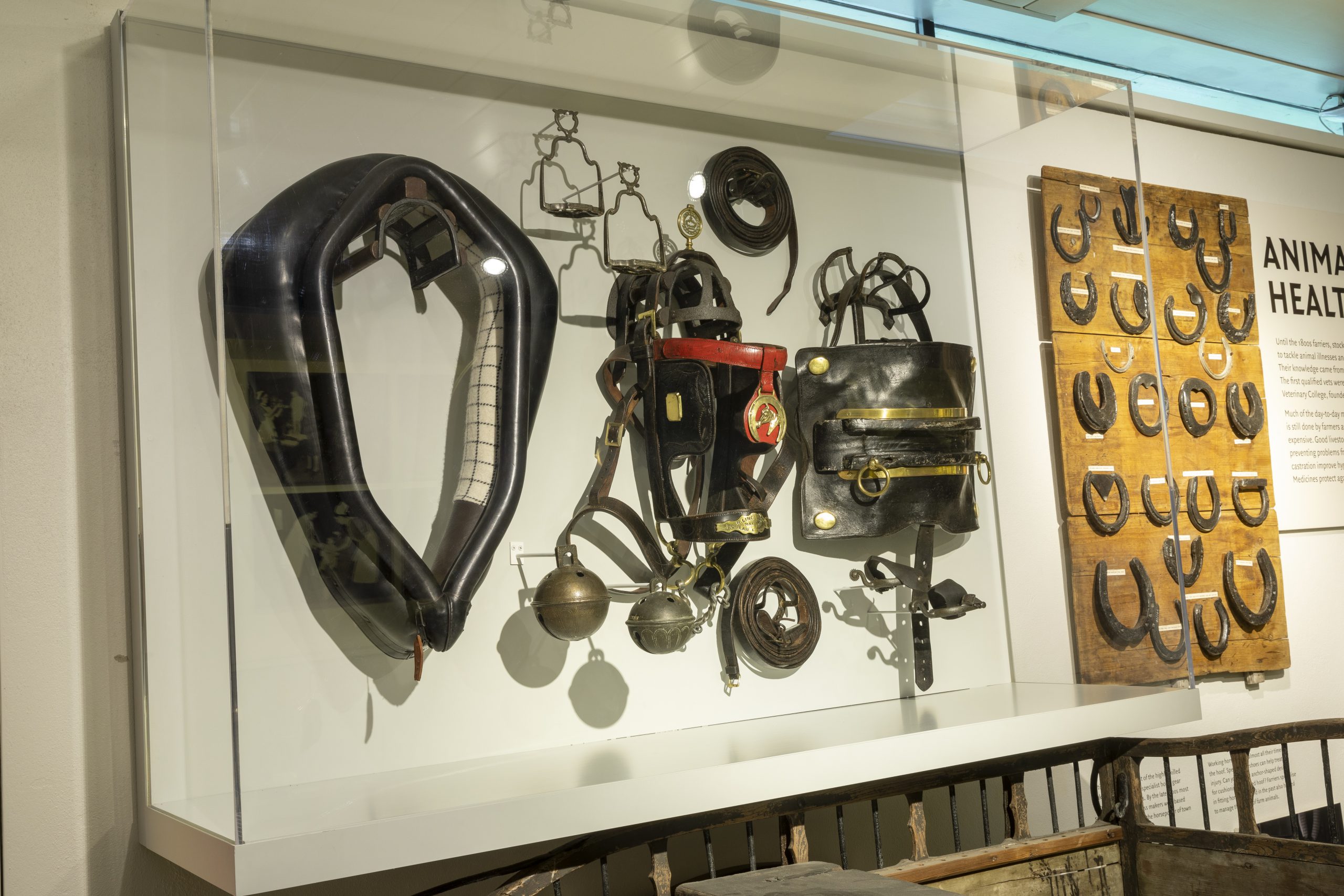
Horse Power
Horseshoe Display
Horse Bell
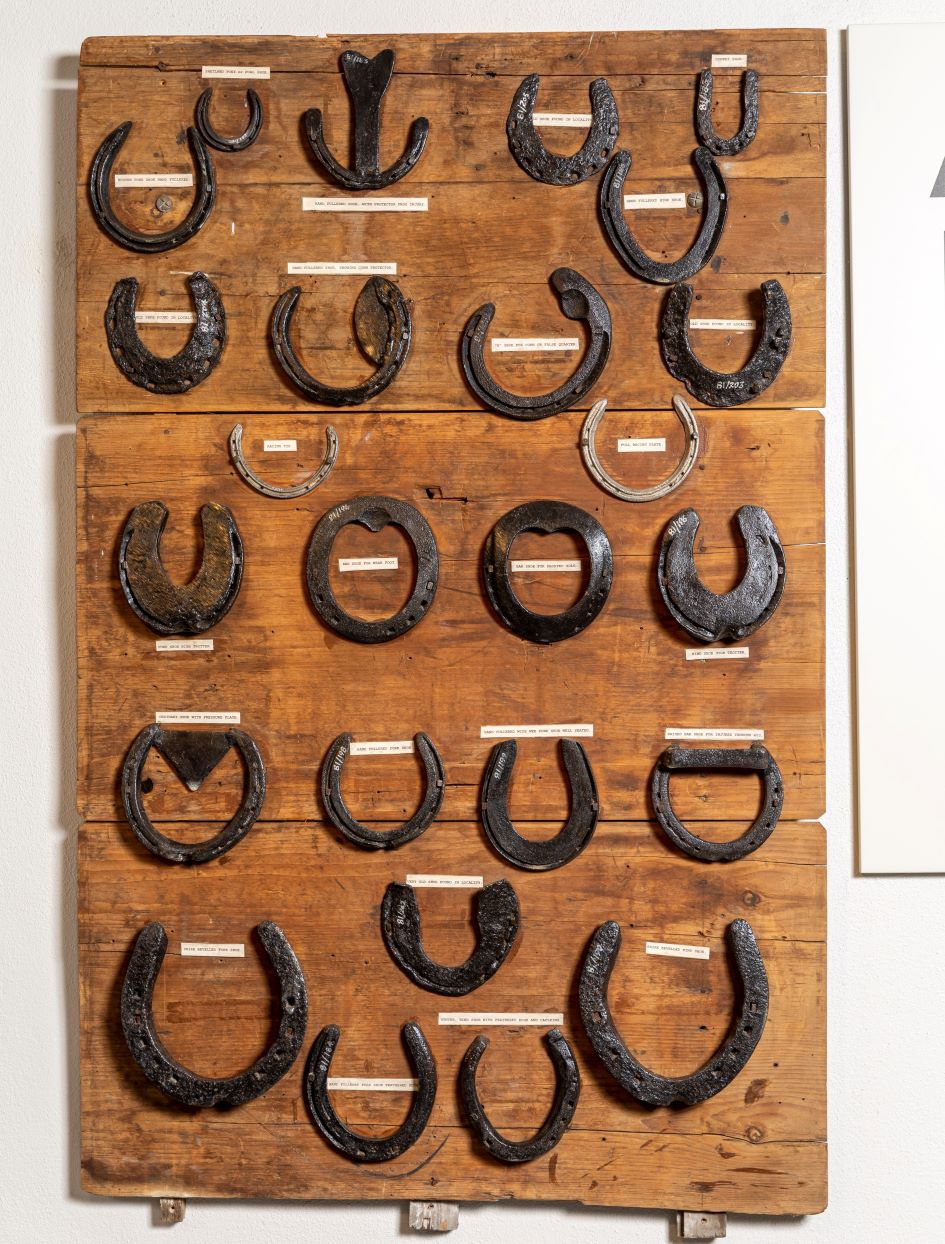
Horseshoe Display
This is a hand fullered horse’s fore-shoe. It was made by J. B. Packer & Son in Uffington Forge, Uffington, Oxfordshire. The collection was hung up on a board in the garage at ‘Curtis Cottage’. Each shoe had a typed label. 3 generations of the Packer family worked in the forge at Uffington. Henry E. J. Packer employed three to four men and they did a variety of work such as tractor and plough repairs involving welding, and wrought iron work as well as providing the service of farrier. In 1930 at the ‘Annual Farriery Competition’, organised by Berks. Co. Co., Henry E. J. Packer won first prize
81/181/205
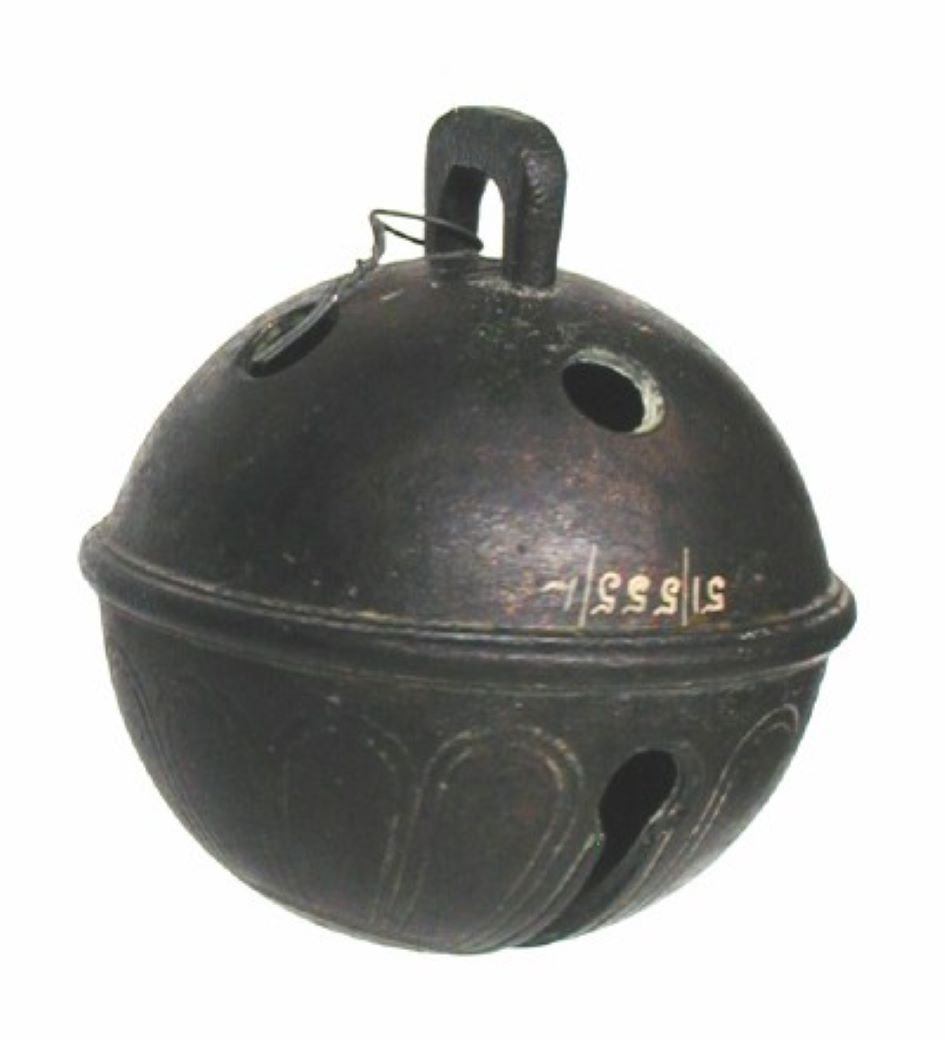
Horse Bell
This large pack horse bell, also known as a ‘rumbler’ or ‘crotal bell’, was made by Robert Wells of Aldbourne, Wiltshire, and probably dates from the eighteenth century or early nineteenth century. It is number 26 of a set. Most of the horse bells one finds are stamped RW for Robert Wells whose family were an old bell founders company in Aldbourne, Wilts. Their works were afterwards sold and became the foundation of the Whitechapel bell foundry
51/555
Rural Healthcare case 1
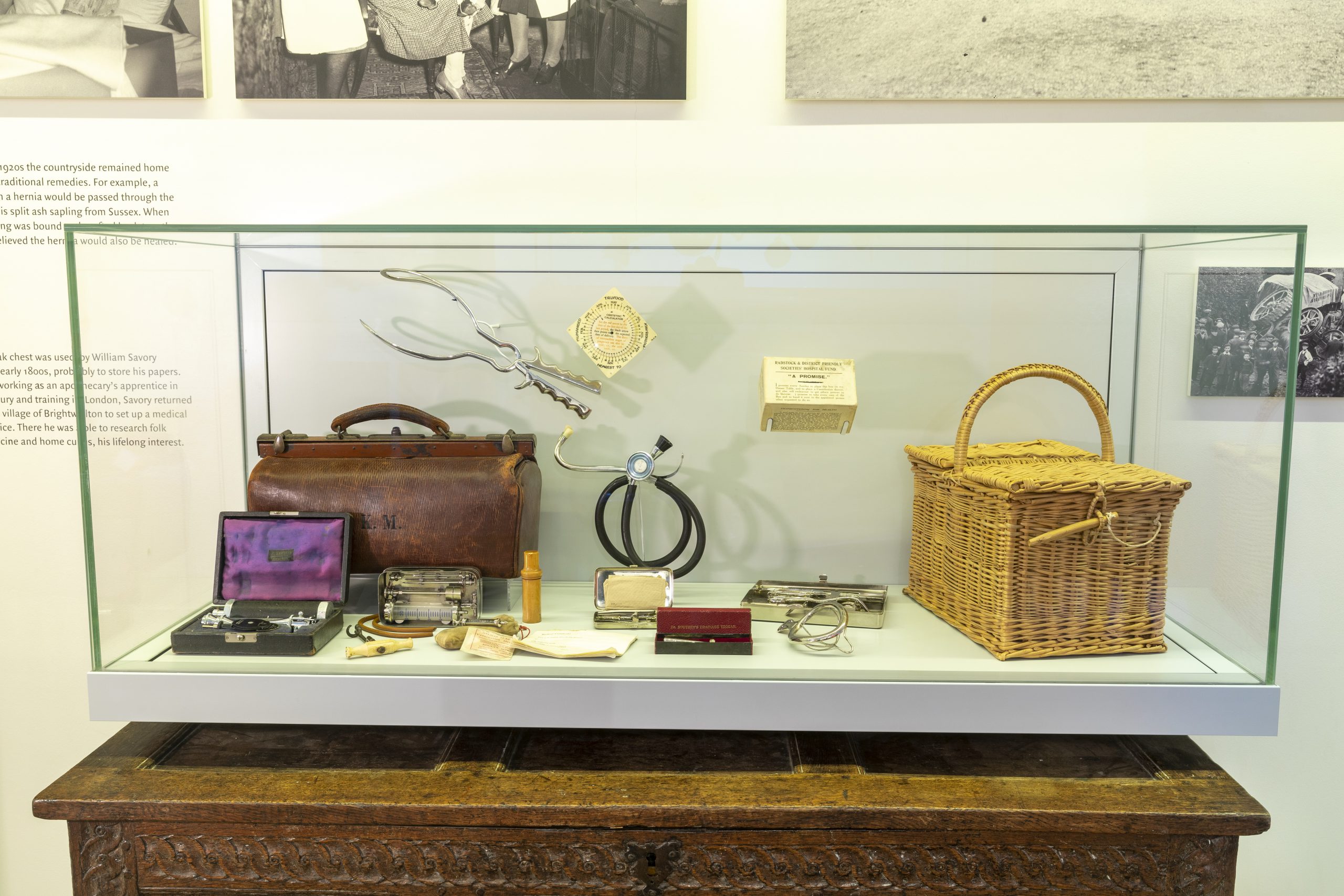
Rural Healthcare case 1
Vaccination Dressing
Doctor's Certificate
Mask
Stethoscope
Trochar
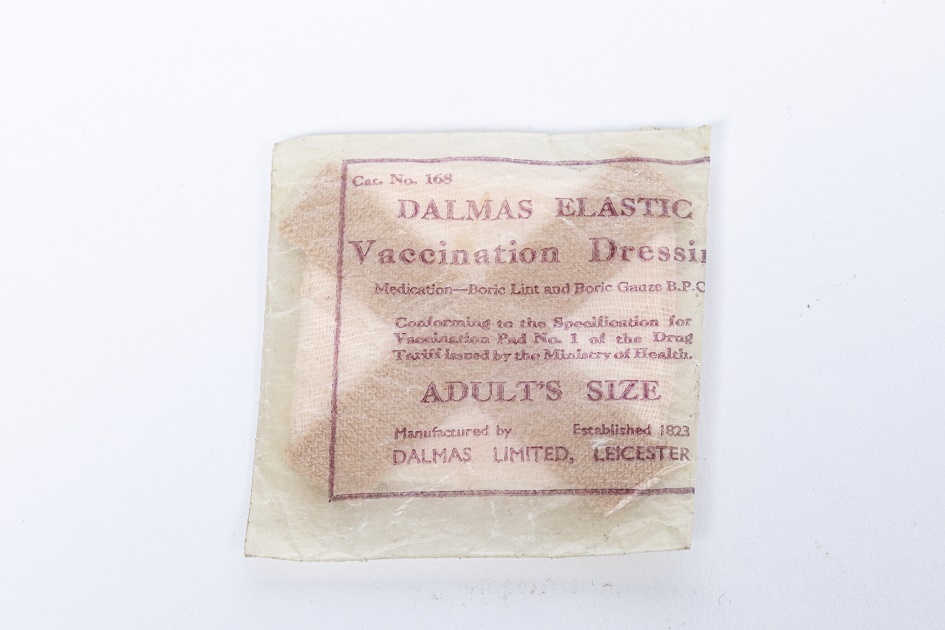
Vaccination Dressing
The dressing is to cover the area of skin where the vaccination has been given by injection. Vaccination stimulates the body’s immune system to protect a person against disease. Smallpox was a highly infectious disease which began with a fever and a rash that spread all over the body. The rash then turned into pustules. Many cases were fatal.
In 1796, the physician Edward Jenner noticed that milkmaids in his area of Gloucestershire were often immune to smallpox. Their work brought them into contact with cowpox, a mild disease of cattle. Jenner injected a boy with cowpox matter and the boy was later immune to smallpox. This is thought to have been the first ever vaccination.
BMHC 2010.16.30

Doctor's Certificate
These certificates are those required by the National Insurance Act 1911. This act, sponsored by Lloyd George, introduced the first national sickness insurance, initially only for working men. This was the first step on the road to the formation of the NHS in 1948. National Insurance provided welfare provision for workers. The act provided for sick pay and unemployment pay in some industries. Workers would receive 10 shillings per week for the first 13 weeks of sickness and then 5 shillings a week for a further 13 weeks if absent longer. Funding National Insurance came from the worker, employer and taxation. For the health-related aspect of National Insurance the worker paid 4d per week into the insurance fund; the employer 3d and taxation 2d.
BMHC 2010.16.29
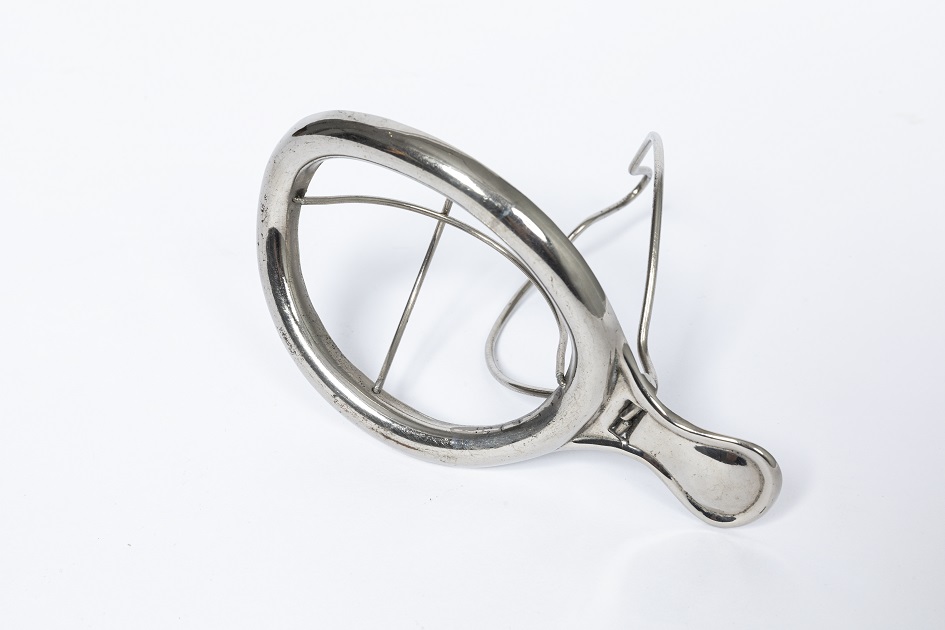
Mask
The Schimmelbusch mask, a system for delivering anaesthetic, was invented in 1889, and was used until the 1950s. The device consists of a wire frame which is covered with gauze and placed over the patient’s mouth and nose. Then high-volatility anaesthetic – usually ether or chloroform – were dripped on it, allowing the patient to inhale a mix of the evaporated anaesthetic and air. “The rag and bottle technique” would have been the method of anaesthesia used by GPs, before the days of the NHS, when performing minor surgery in patients’ homes. One tale has been told of a child who had his tonsils removed on the kitchen table, in the 1920s, in Ealing.
BMCH 1979.1.19
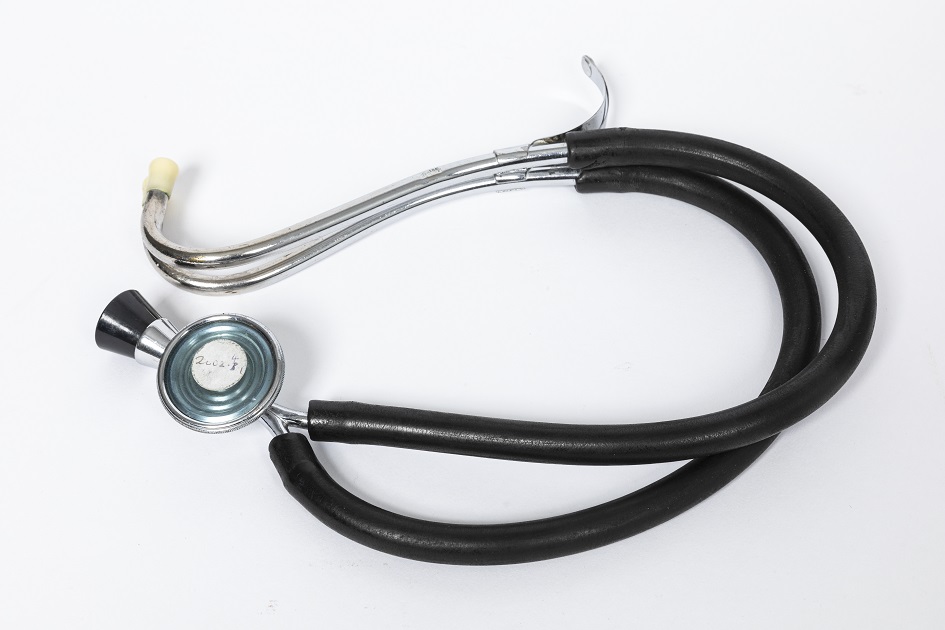
Stethoscope
A stethoscope is used for listening to the internal sounds of the body in the lungs, heart and bowels. French physician René Laennec invented the stethoscope in 1816. He considered it improper to listen to the sounds of the heart of a female patient by putting his head directly on her chest. Instead, he rolled up a piece of paper into a tube and placed one end on her chest and the other at his own ear. He subsequently developed a robust wooden tube to replace the makeshift paper one.
In the 1850s the hollow wooden tube was replaced by the binaural stethoscope. These stethoscopes featured two earpieces connected by a tube to a ‘bell’ that is placed on the body.
Most of the objects in this case are on loan from the Berkshire Medical Heritage Centre. Many thanks for their permission to highlight these objects on the tour.
BMHC 2002.4.1
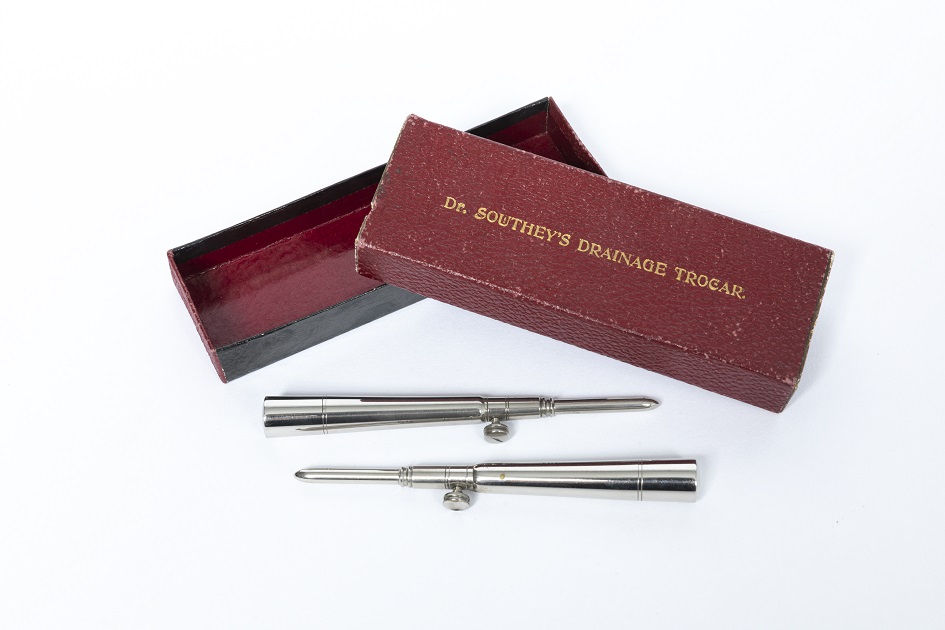
Trochar
A trocar is a surgical instrument with a sharp point which is used to create a hole in the body which can be used to introduce surgical tools. This trocar was used by a General Practitioner (GP) in the first half of the 20th century. It would probably have been used to perform a tracheotomy in a case of Diphtheria. A membrane forms over the top of the trachea, windpipe, and causes asphyxia. The trocar was used to make a hole in the trachea and a tube called a canula was then inserted to keep the hole open so the patient could breathe.
This was a lifesaving procedure. Diphtheria was rife in England until compulsory vaccinations were introduced in the early 1940s.
BMHC 2010.16.13
Rural Healthcare case 2
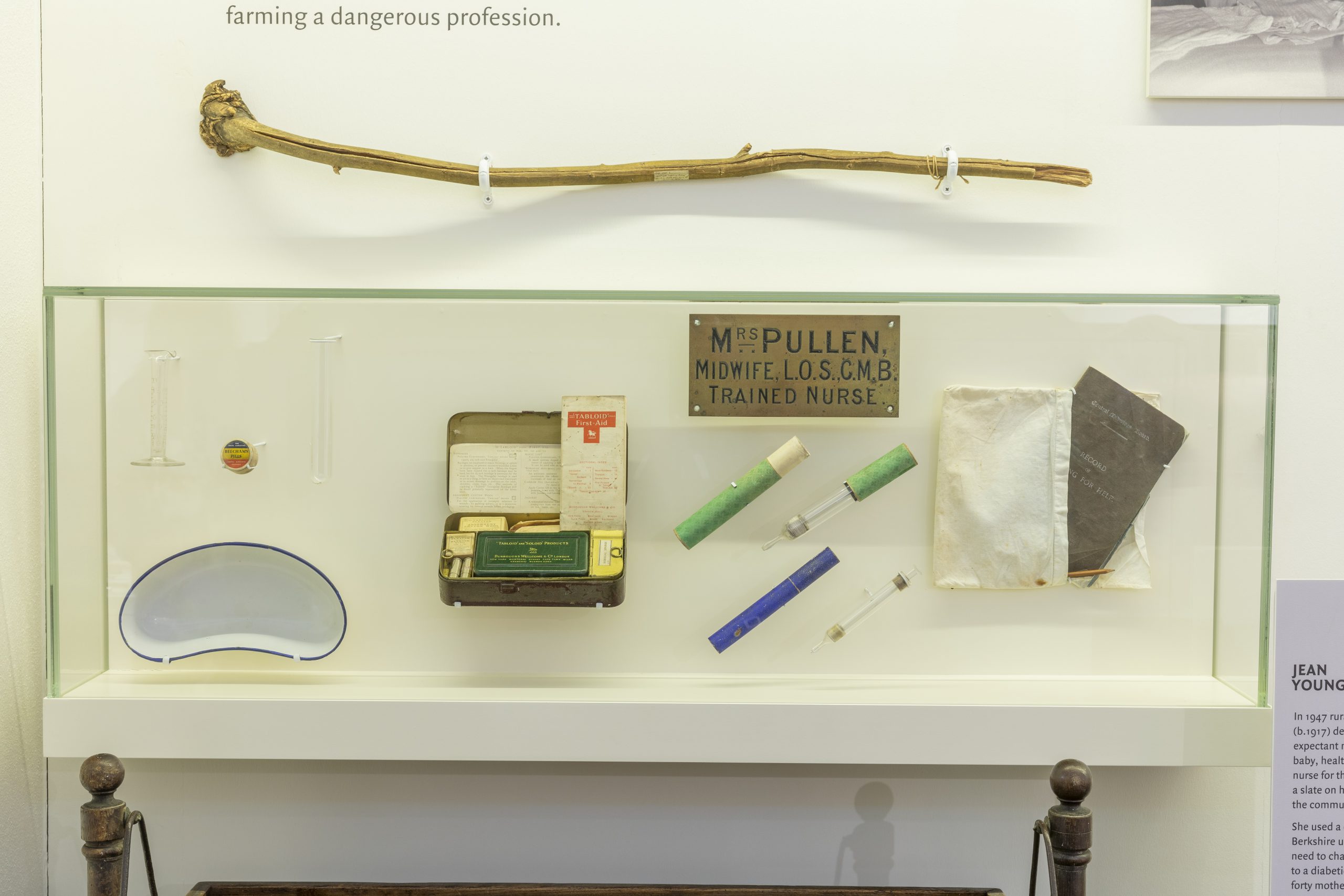
Rural Healthcare case 2
Midwife's Notebook
Sapling
Tabloid First Aid Kit
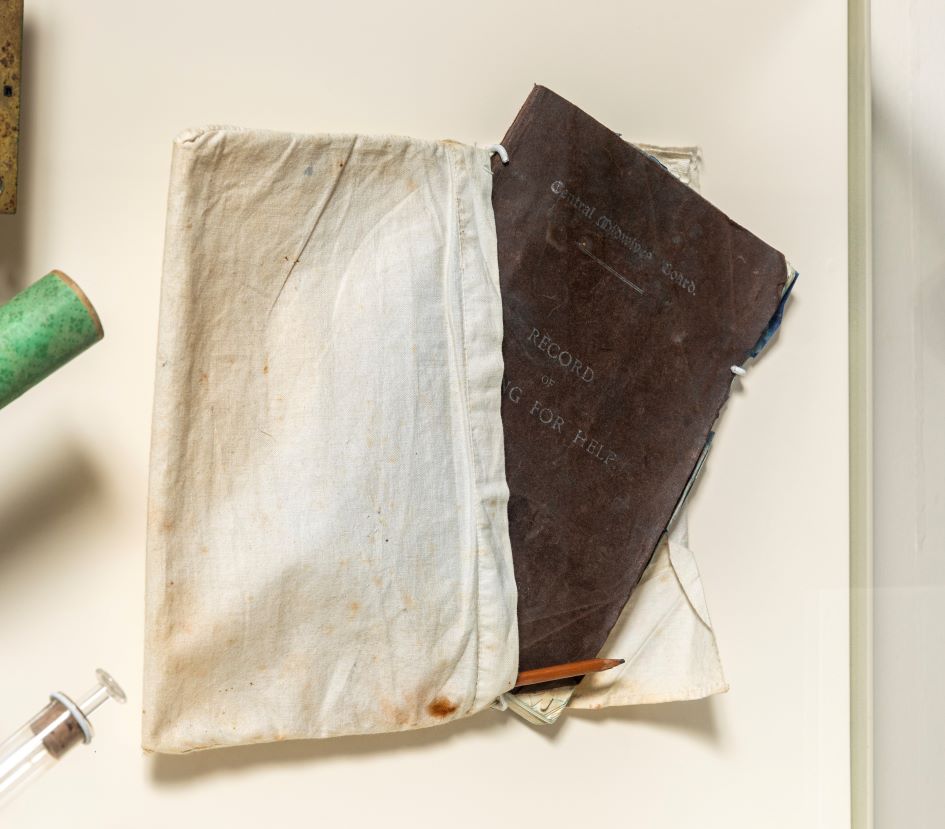
Midwife's Notebook
The Central Midwives Board was set up by the Midwives Act 1902. This prohibited unqualified and unregistered women from practising midwifery. The aims of the act were ‘to secure the better training of midwives and to regulate their practice’. Each registered midwife had to keep a record in the notebook of when they sent for help from a doctor, during labour and childbirth while performing home deliveries. The notebook cover has an inscription reading “Central Midwives Board, Record of Sending for Help”.
This notebook was used by Georgina Pullen. She trained and registered as a midwife in 1904. One case recorded in the notebook states that on “October 16th Dr. Farr sent for on behalf of Mrs. Bell who has a ruptured perineum.”
MERL 2010/25

Sapling
Until the 1920s many traditional remedies were used which were a mixture of common sense combined with inherited lore about the healing properties of plants. This split ash sapling comes from Sussex. It was believed that a child could be cured of a hernia by passing it through the gap in a split ash sapling. The sapling was then bound and grafted back together and it was thought the hernia would repair as the sapling did.
Ash saplings were mainly used for this ritual cure because it was generally considered to be a magical tree. A spoonful of ash sap was once given to new-born babies in parts of England as a protection against ill health and witchcraft. The local wise man or woman carried out this magical healing although it might also be attempted by a relation. Many thanks to the Folklore Society for loaning us this item.
FLS 1905.3
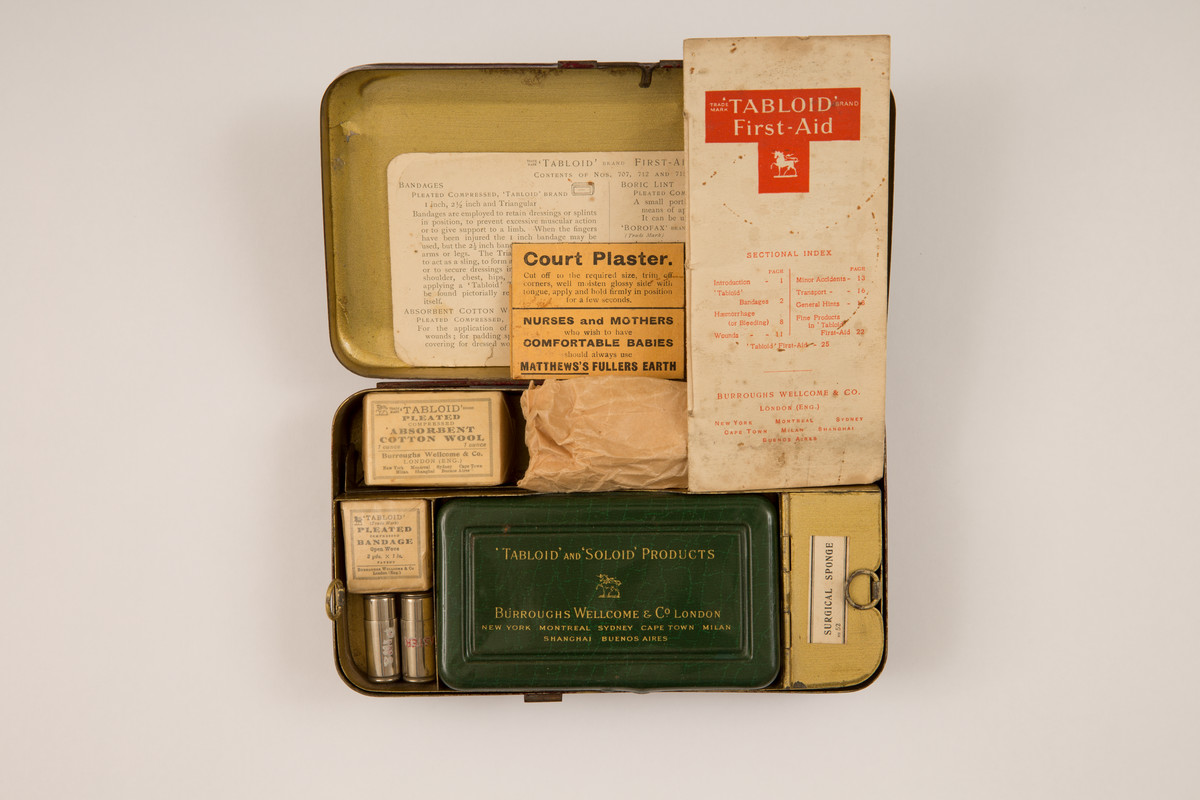
Tabloid First Aid Kit
This First Aid kit was made by the pharmaceutical company Burroughs Wellcome, which produced a wide range of specialised kits – for explorers, the army and civilians, of which this is one. The contents include; tweezers, scissors, smelling salts, adhesive plasters, cotton wool, triangular bandage, antiseptic, remedies for stomach upsets, surgical sponge.
The first aid kit was used by Georgina Pullen of Andover, Hampshire and Hambleden, Buckinghamshire, during her work as a rural nurse and midwife in 1904-17. Furthermore, this model of First Aid kit No. 715 was used by Alcock and Brown on their first transatlantic non-stop flight on 14-15 June 1919.
MERL 2004/17
Animal Health Case - Part 1
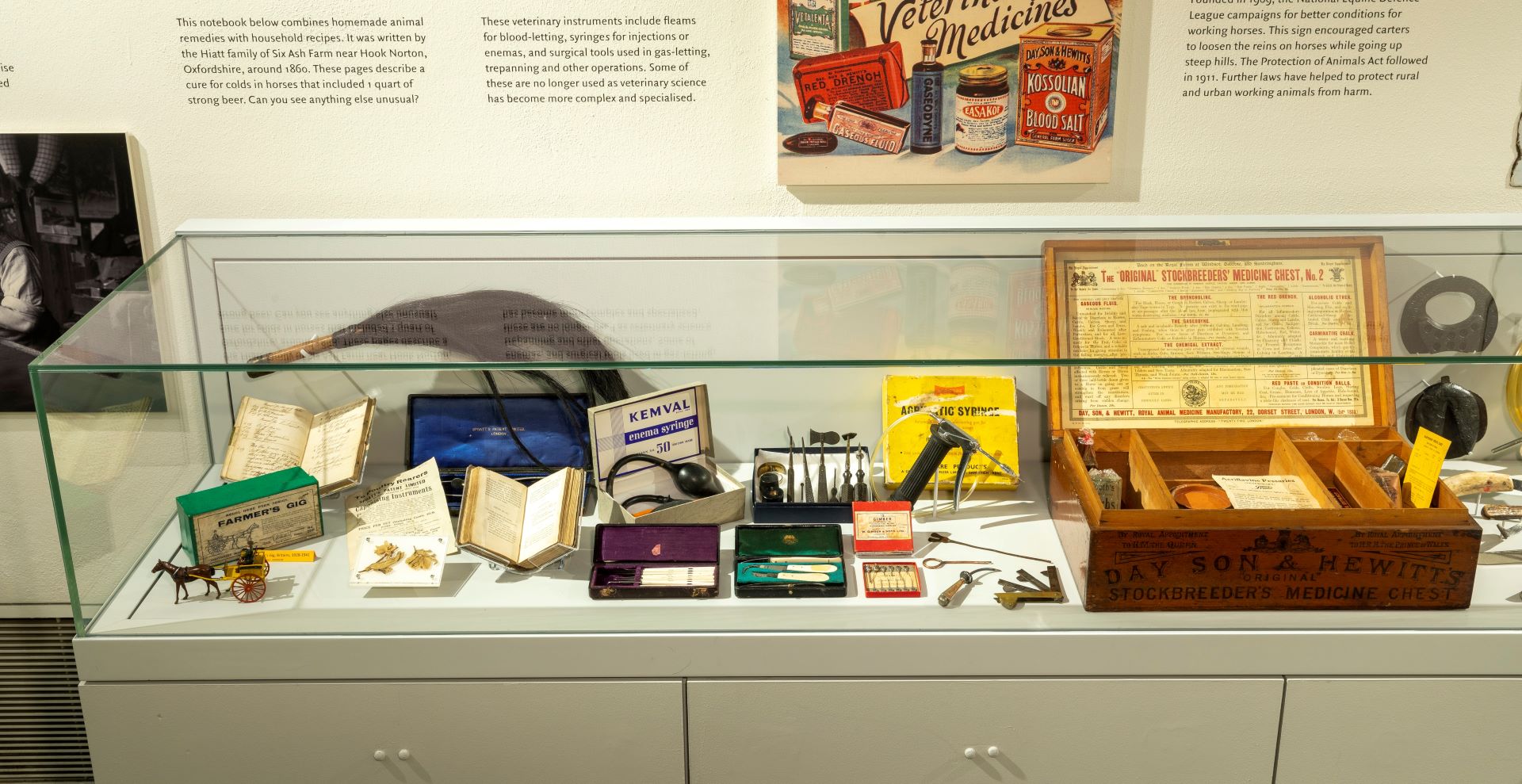
Animal Health Case - Part 1
Fly switch
Hellebore sample
Clater's Cattle Doctor
Trochar and cannula
Farmer's notebook
Caponiser
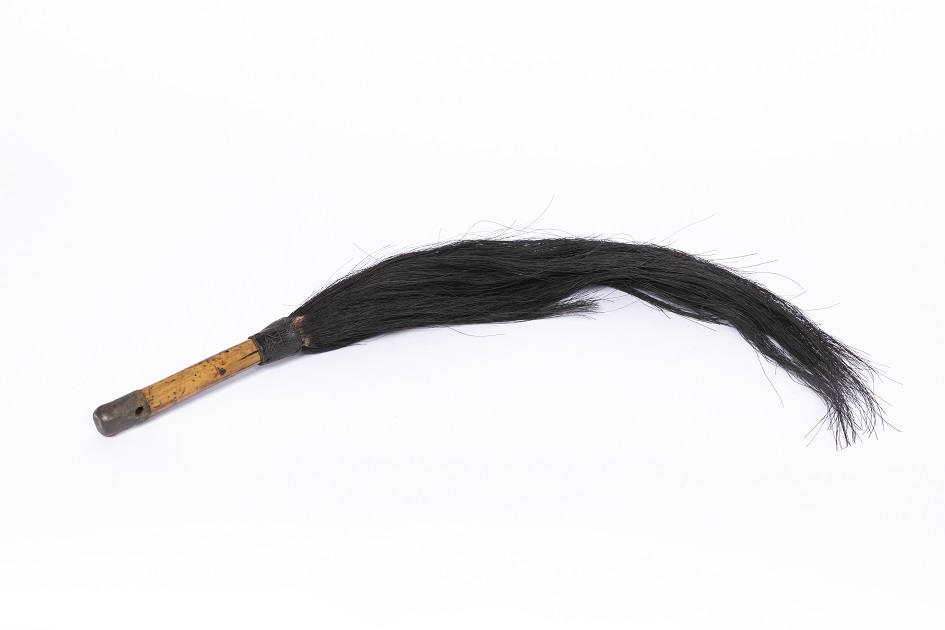
Fly switch
Produced in the early 20th Century (1900 – 1924), the main components of this fly switch / twitch are made from metal, leather, and horsehair. This item served two purposes. One is a decorative twitch that is used to sooth horses during stressful situations, such as shoeing. The other is to brush flies off horses during the shoeing process.
MERL 55/181
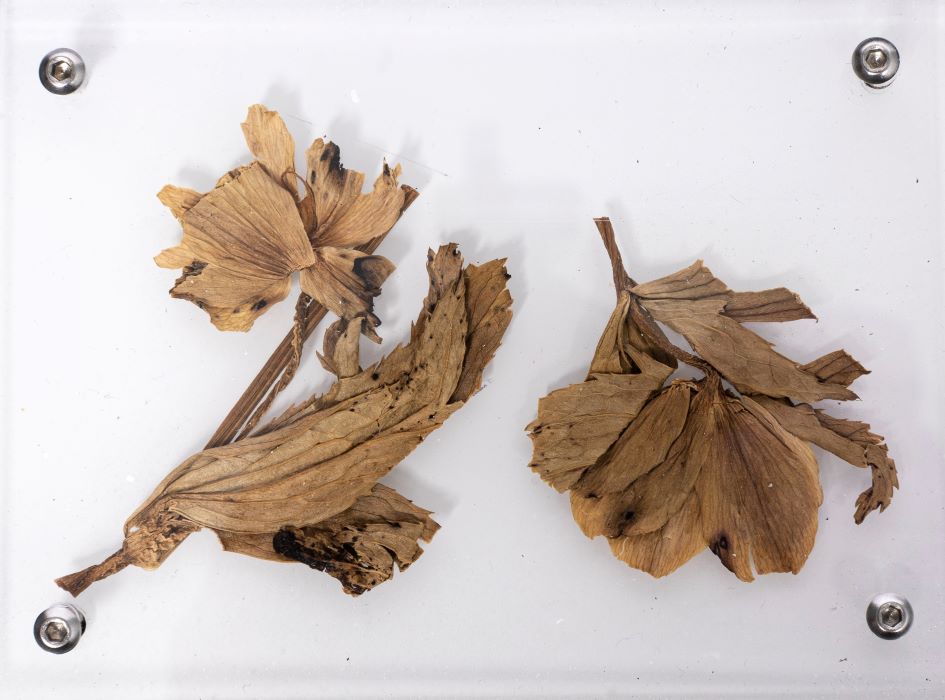
Hellebore sample
This is a sample of dried hellebore which was used in the Dales area of Durham (Weardale, Teesdale), where it was known as ‘felon grass’, as a last resort to treat a cow on which a vet had given up. A cut was made in the skin of the animal, and a hellebore leaf inserted under the skin. The cut was stitched up and the hellebore left for ten days before being removed. These were cut & dried in summer and were used in dry form throughout winter – most users preferred fresh material in season.
MERL 60/150
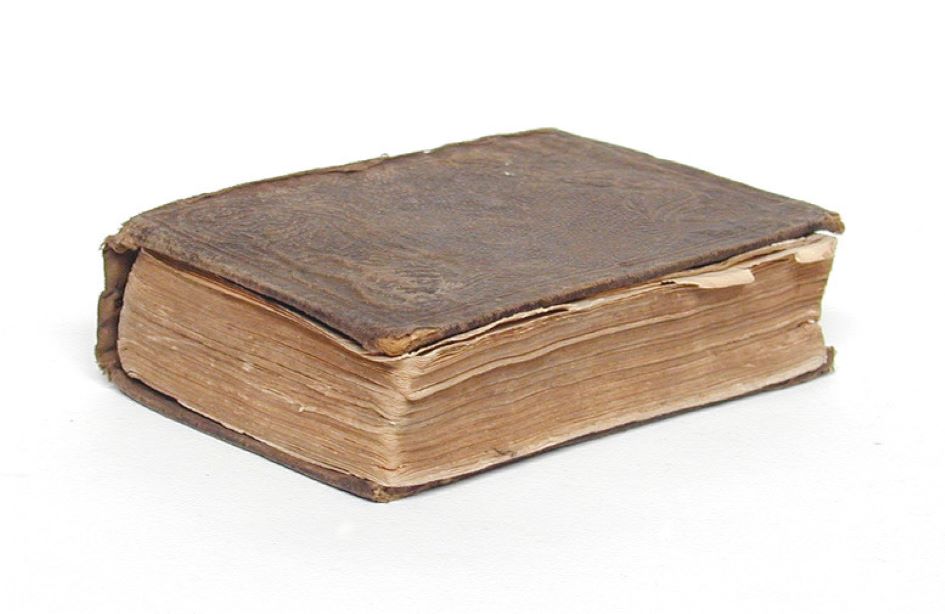
Clater's Cattle Doctor
This book was originally written by Francis Clater in 1810 and was re-printed in 1814, 1844, 1846, 1853, 1870 and possibly other years. The 1870 edition was almost entirely re-written by “Armytage” which omitted much conjecture. The book is primarily about the diseases of cattle and gives some remedies. It also contains a section about sheep, and has been selected by scholars as being of cultural importance.
MERL 87/19
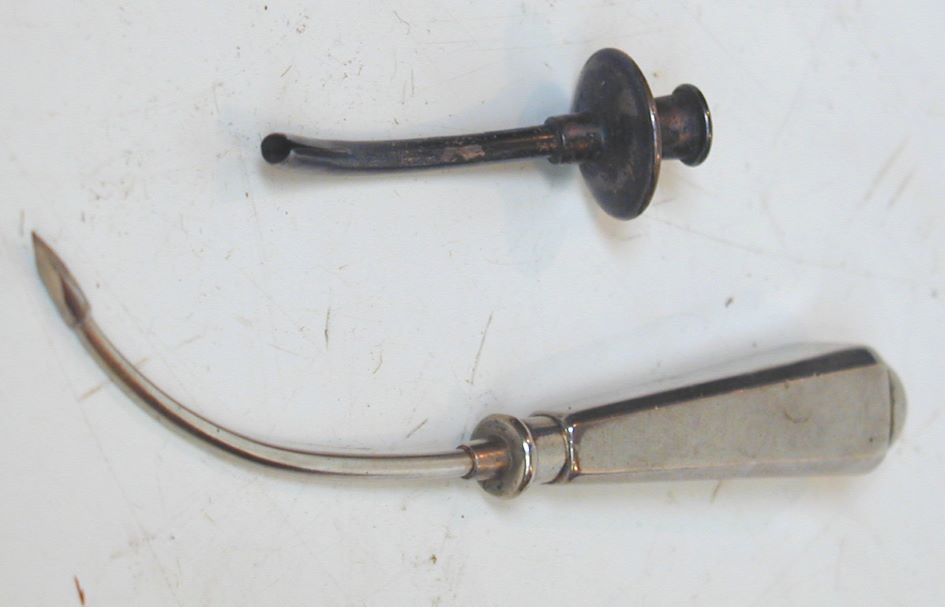
Trochar and cannula
This piece of equipment is called a trochar and cannula and was used for drawing off fluid or gas in an animal. It consists of the trochar, a steel spike, and the canula, a metal sleeve with a collar at the handle end. After insertion, the trochar is removed, leaving the cannula to act as a vent.
MERL 2002/32

Farmer's notebook
This notebook was created by John Hiatt, a farmer, to record recipes for household and veterinary uses, such as medicines. John Hiatt was the farmer at Six Ash Farm from 1860. The Hiatt family farmed ninety acres of land here until they left in 1947. They also owned drapery businesses in nearby towns.
FR OXF 4/3/1
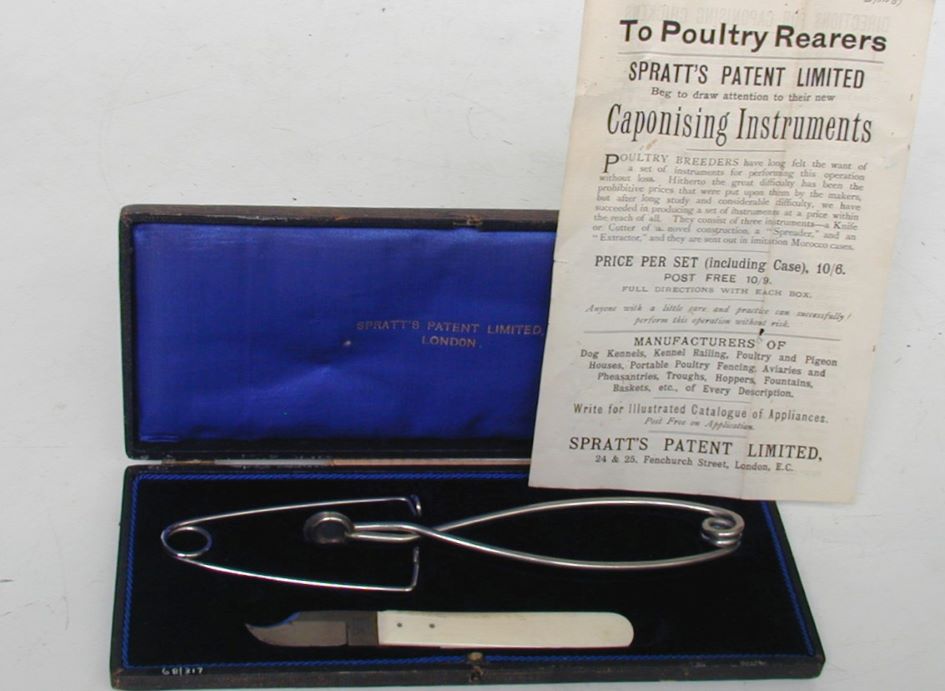
Caponiser
The box includes: a knife, spreader, extractor, box, and instructions. It is used for castrating cocks (male chickens). It was produced by Spratts Patent Ltd.
Spratts was founded by James Spratt c. 1860. Originally an electrician from Cincinnati, Ohio, Spratt was the first person to manufacture dog biscuits on an industrial scale, establishing his headquarters in Holborn, London. Spratt also pioneered the concept of animal life stages, with appropriate foods for each stage, a concept widely in use to this day. Additionally, Spratts was the first company to erect a billboard in London.
MERL 68/317
Animal Health Case - Part 2
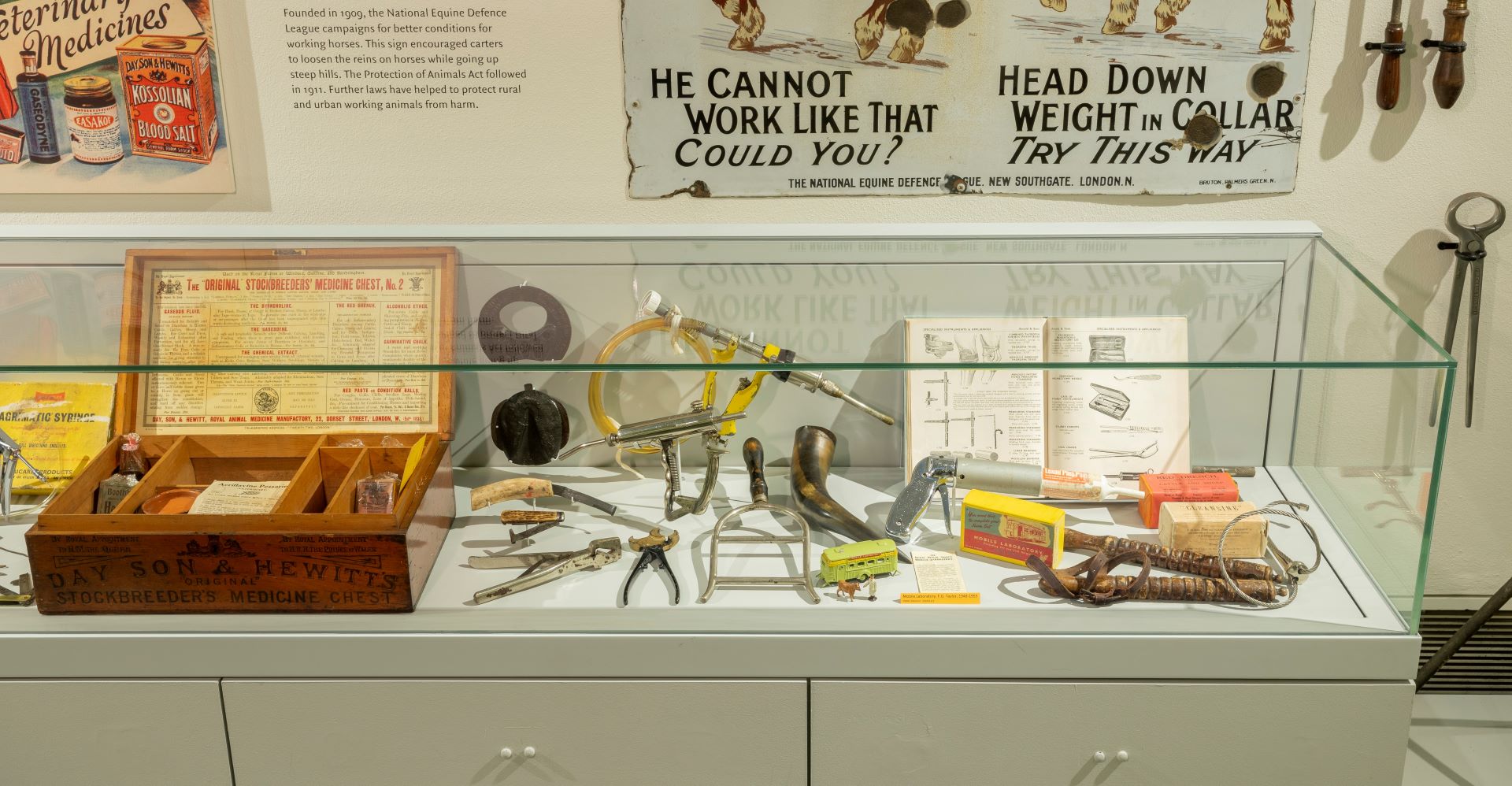
Animal Health Case - Part 2
Drencher
Birthing noose
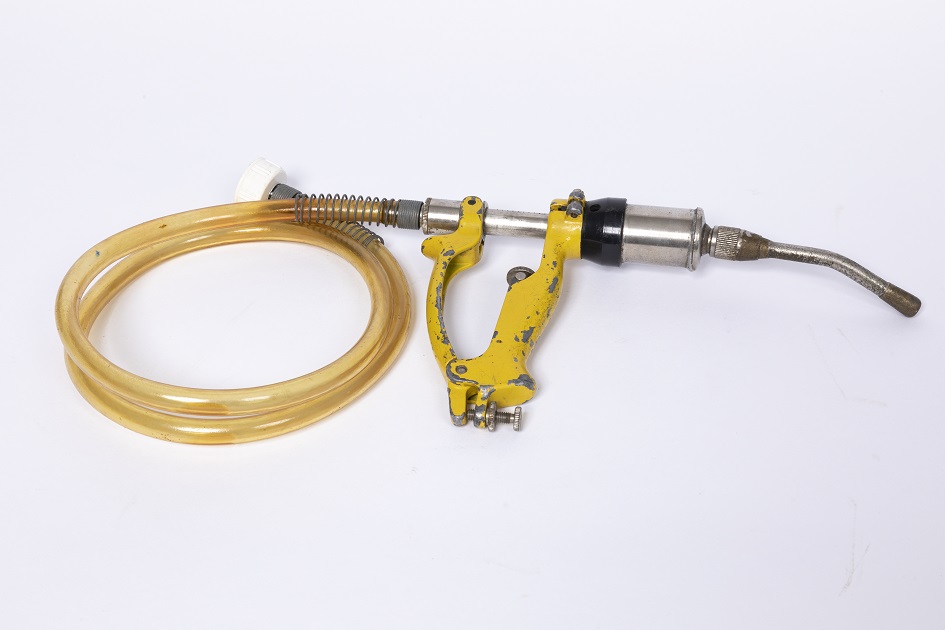
Drencher
This drencher forms part of a collection of objects donated to MERL by Mrs Jayne Traill. It was used by the donor’s grandfather, Joseph Bevan, who would have used it to administer medicine to livestock. The plastic tubing would be attached to a plastic container backpack holding the drenching solution. The drencher was manufactured by Coopers in Berkhamsted, Hertfordshire who were famous for their ‘Sheep Dip’ medicine.
MERL 2012/438
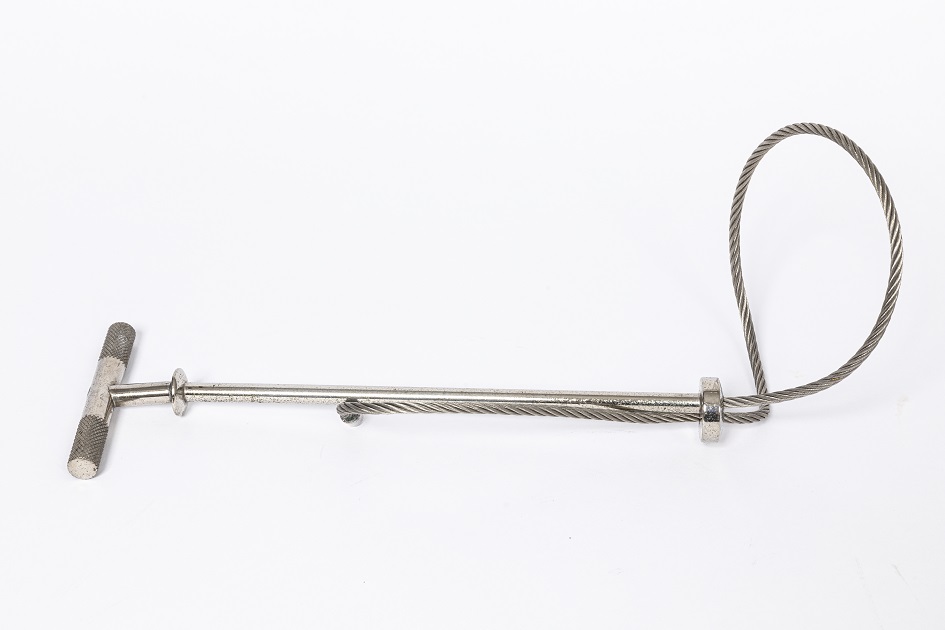
Birthing noose
This item was originally recorded as a ‘birthing noose’. It may well have been used in animal birthing but was most likely originally designed to be a pig snare, used to capture large pigs by the snout. It forms part of a collection of objects donated to MERL by Mrs Jayne Traill. It was used by the donor’s grandfather, Joseph Bevan, who farmed at Miltons Farm on the Ascot Place Estate from 1967 to 1986.
MERL 2012/444
Animal Health Display
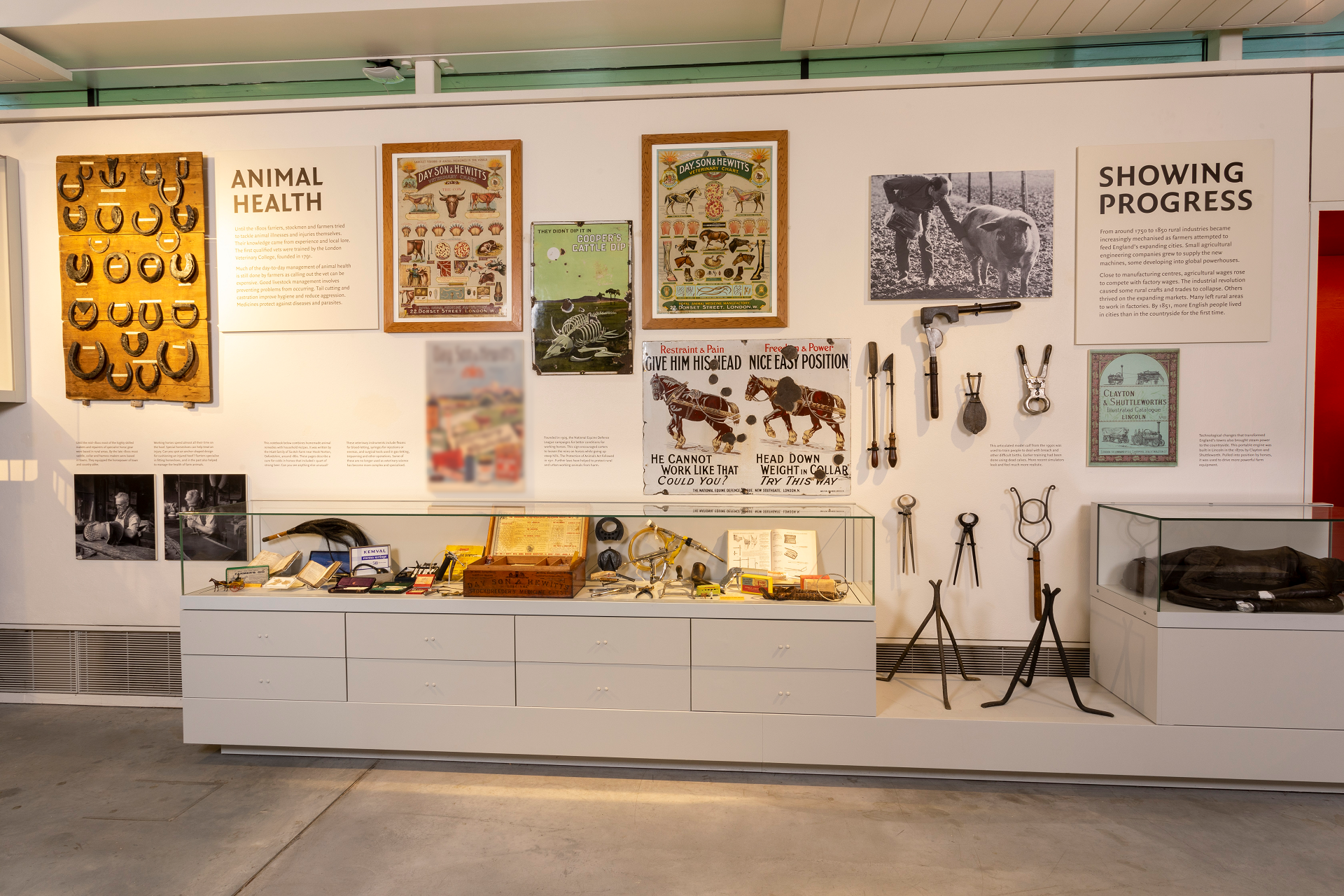
Animal Health Display
Horse Gag
Model Calf
Cooper's Cattle Dip Sign
Tooth rasp
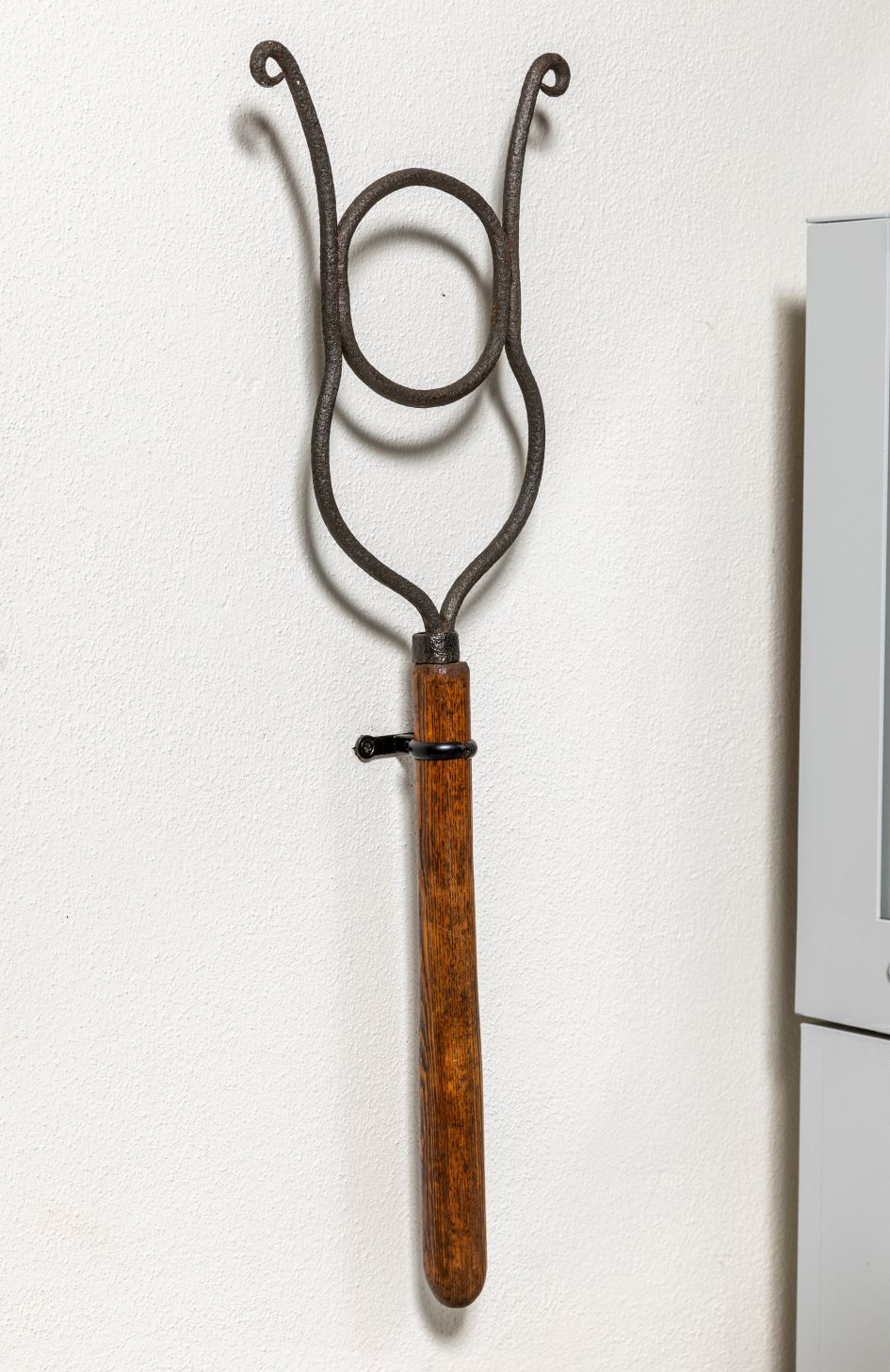
Horse Gag
This horse gag was placed in a horse’s mouth to keep it open whilst dental work was undertaken. Throughout the 20th century, some uncertainty existed as to who was responsible for equine dentistry. Livery stables and blacksmiths had traditionally performed this work, but as they declined, their knowledge was lost. It was often up to farriers to do the best they could. In the modern day, equine dentistry is more widely practiced by veterinary professionals.
68/106
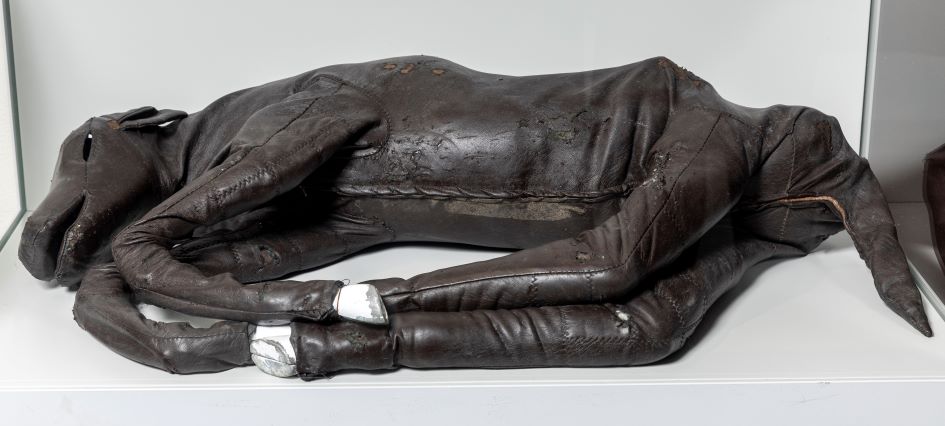
Model Calf
Probably used by the Agricultural Training Board, this leather covered metal calf was used to aid cowmen in learning to birth calves. It would be placed in a wooden or plastic uterus in various positions that mimicked birthing complications, to train subjects in manoeuvring calves to a safer birthing position. The correct position for a calf to be born is back side up, with legs stretched along the birthing canal. In 95% of births this occurs naturally, but sometimes the calf must be moved into this position and pulled out.
2014/15
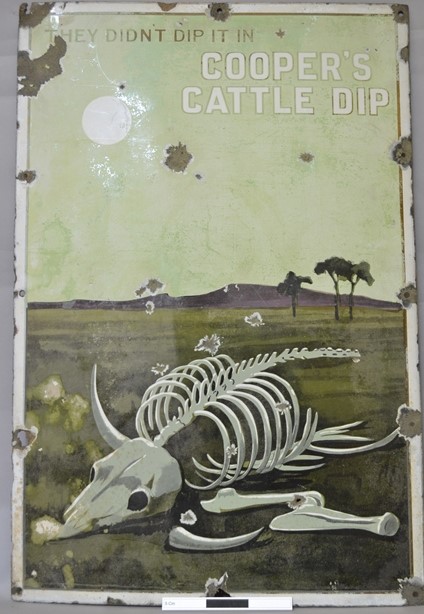
Cooper's Cattle Dip Sign
Advertising Cooper’s Cattle Dip, this sign predicts a grave fate for cows not submerged in their product. Next to a cow skeleton is written “They didn’t dip it in Cooper’s Cattle Dip.”
William Cooper started his business in 1840 in Berkhamstead, becoming a pioneer in the production of chemical sheep and cattle dips. These would submerge livestock in a concoction of chemicals, killing parasites such as ticks, flies and lice. Becoming Cooper, McDougall and Robertson in 1925, the company expanded from livestock dips. During World War 2 they produced an anti-louse powder to kill a parasite which had caused trench fever and typhus among the troops.
76/284/1
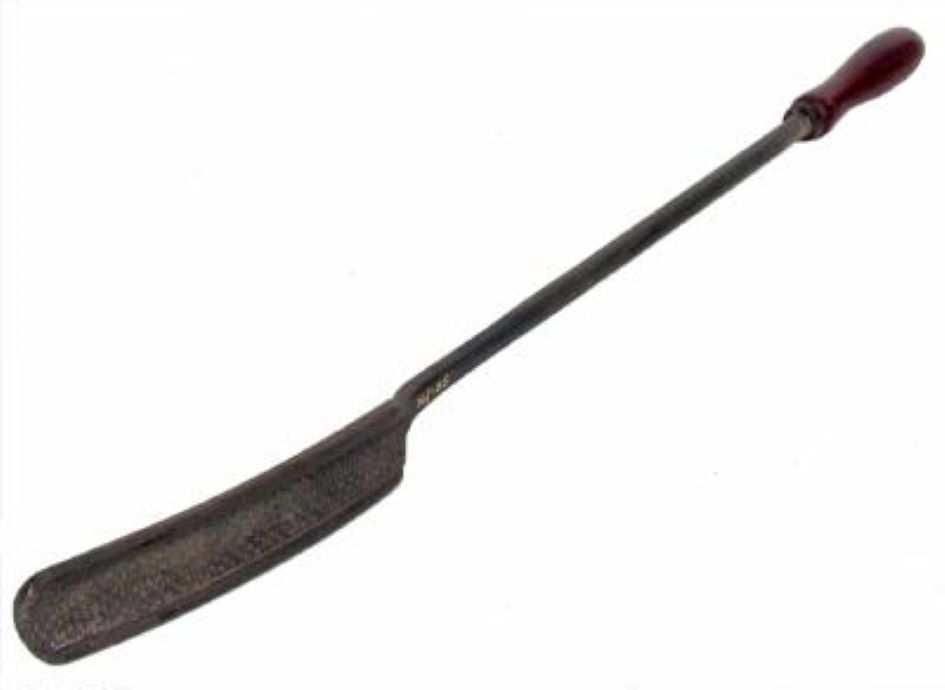
Tooth rasp
Used by a family of horse dealers in Reading, this tooth rasp was applied to wear down a horse’s teeth, in order to blunt the points and balance the horse’s mouth. Before rasping, the mouth must be held open by a gag and a thorough examination conducted to check for broken or missing teeth. The frequency of these examinations depends on the horse’s health and age.
The teeth can actually be used to tell how old a horse is. If it is younger than 11 years, its incisors are rounded. Older horses have triangular or rectangular incisors.
MERL 54/455
Dairy to Doorstep Case
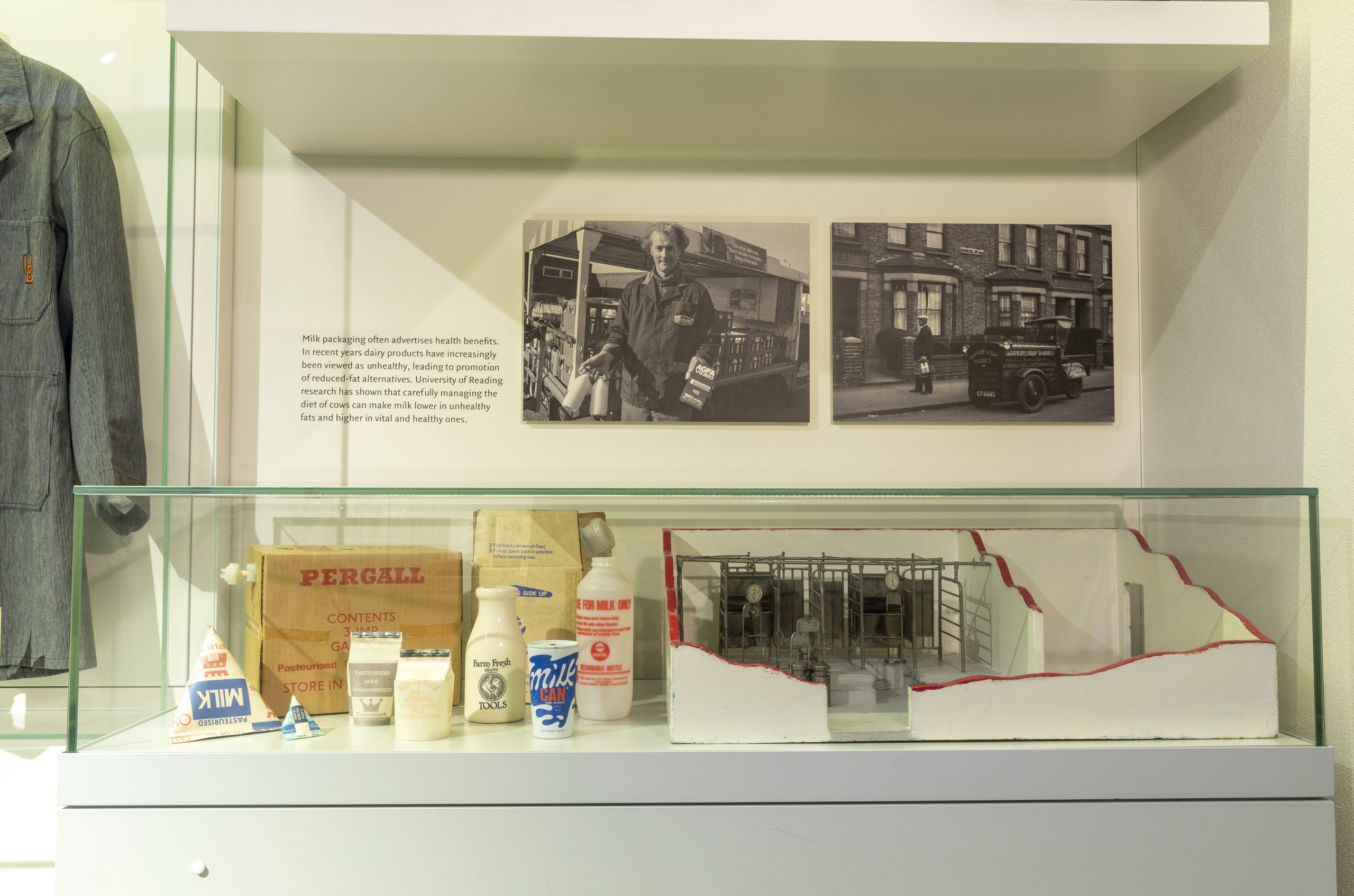
Dairy to Doorstep Case
Milk Container
Milk Cartons
Model Milking Parlour

Milk Container
MERL 72/74
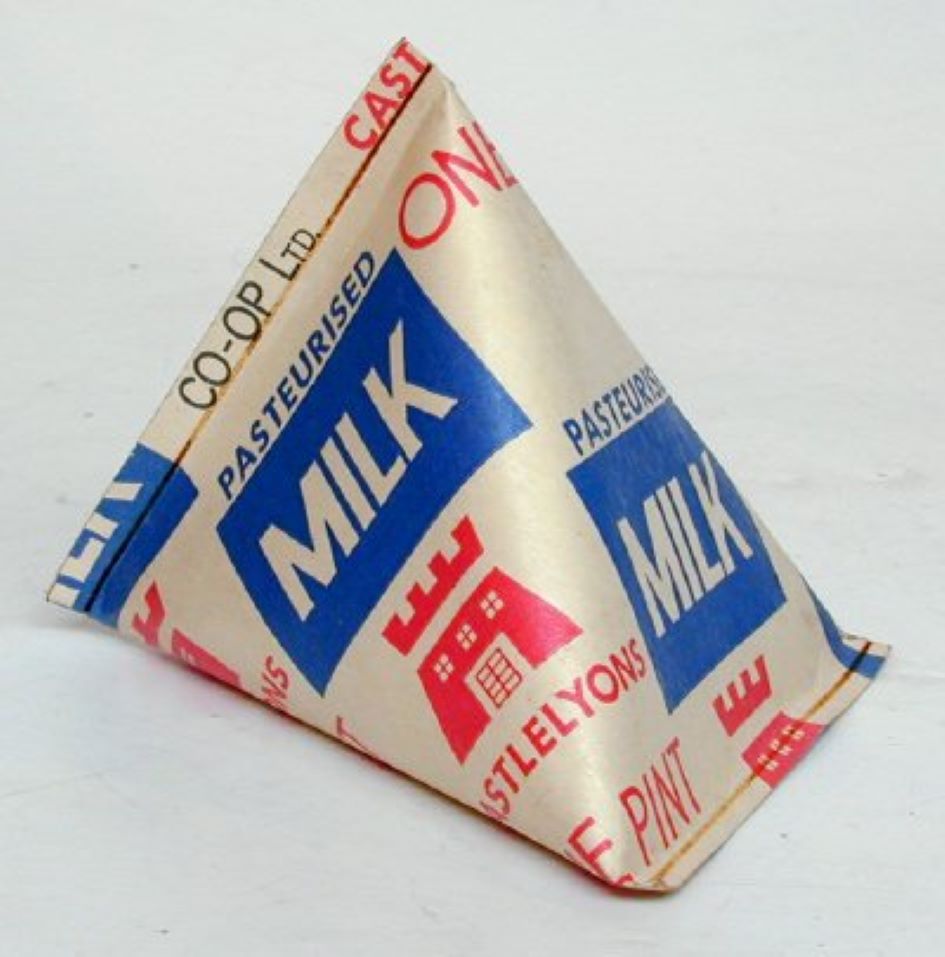
Milk Cartons
These cartons, manufactured by Tetra Pak, are part of a set of various sizes and uses. They are made from wax coated card.
Drinking milk from card-based cartons has long been a staple of school lunches in the UK. They are cheap, convenient, hygienic and ensure each child receives the same quantity of milk. Furthermore, they do not carry the same health and safety concerns of glass bottles. Between 1945 and 1968, all schoolchildren were entitled to a free third of a pint of milk per day. Milk was infamously withdrawn for over 7s in 1971, earning Margaret Thatcher the title ‘milk snatcher’ amongst many commentators.
MERL 72/9

Model Milking Parlour
This model demonstrates the layout of a 1920s milking parlour. It contains weighing scales and frames, wooden churns, feed hoppers and troughs. A milking parlour is a part of a dairy farm where cows are taken for milking. Before refrigeration, parlours were attached to the rear of milk shops and sold fresh milk straight from the udder.
Until the end of the 19th century, cows were milked by hand. Early mechanical milkers used a ‘vacuum’ method to replicate a calf sucking. The surge milker was invented in 1922 which added a tugging motion to the tubes.
96/15
Dairy to Doorstep Display
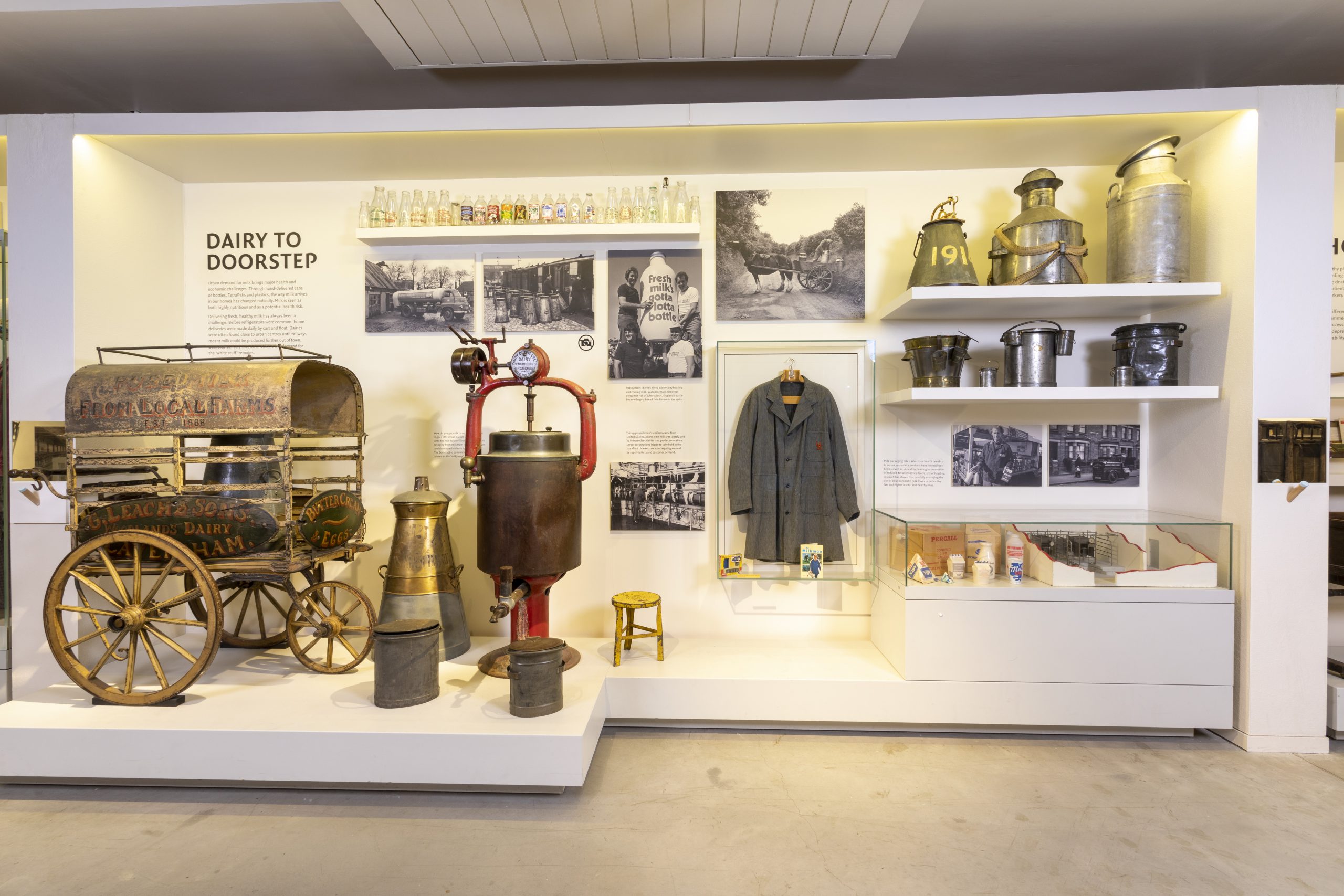
Dairy to Doorstep Display
Pasturiser
Milkman's Coat
Counter Sales Pan
Dairy Cart
Glass Milk Bottles
Milking Stool
Milk Churn
Royal Show Photograph
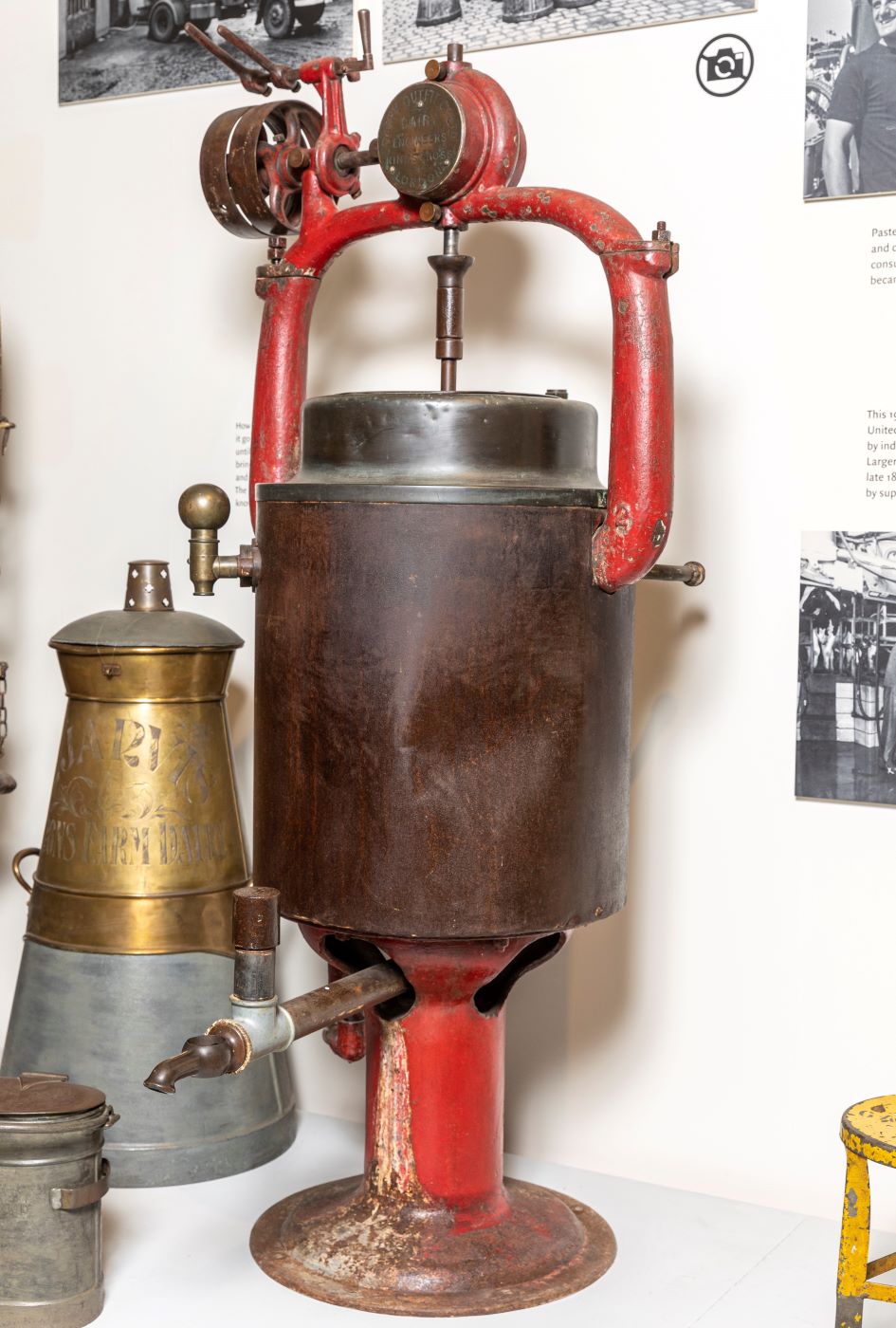
Pasturiser
This pasteuriser was used in a milk processing plant, and was then owned by the University’s Department of Dairying. It contains a paddle for stirring, inlet and outlet pipes for the milk and steam, and a safety valve.
Pasteurisation involves heating milk to 71.7˚C for around 20 seconds. This kills harmful bacteria present within the milk and significantly increases its shelf life. Invented by French micro-biologist Louis Pasteur in 1864, it was slowly adopted across the UK. It was not without opposition; for example, Lady Eve Balfour claimed that a hygienic dairy farmer should be able to produce clean milk without it.
MERL 62/16
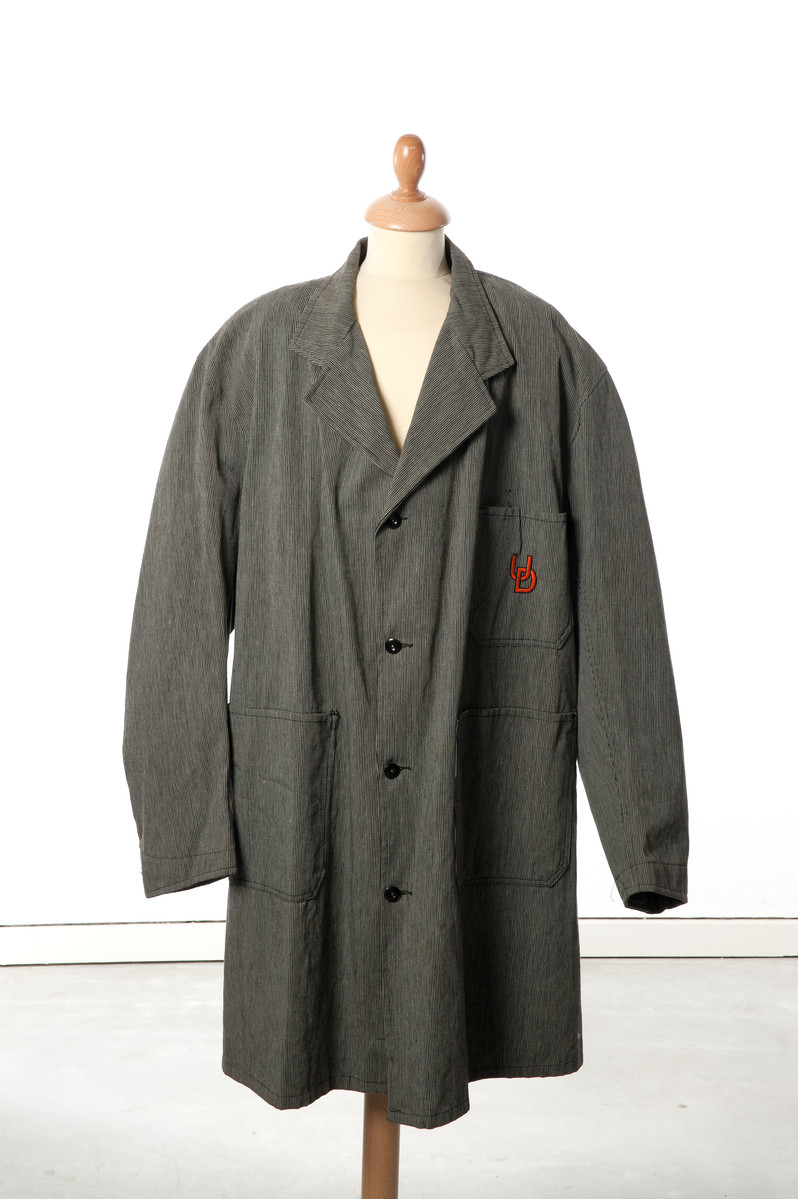
Milkman's Coat
This milkman’s coat would have been worn by an employee of United Dairies, which merged with Cow and Gate’s to form Unigate in 1959. United Dairies was one of the first companies in Britain to pioneer the sale and distribution of pasteurised milk in the 1920s.
Milkmen were introduced to the UK in the mid-19th century, when fresh milk was carried into cities by new railway lines. Due to its short shelf life in the time before refrigeration, it was more convenient for milk to be taken straight to the doors of customers. Cheap supermarket milk, with a longer shelf life, has led to a decline in milkmen.
MERL 2011/11
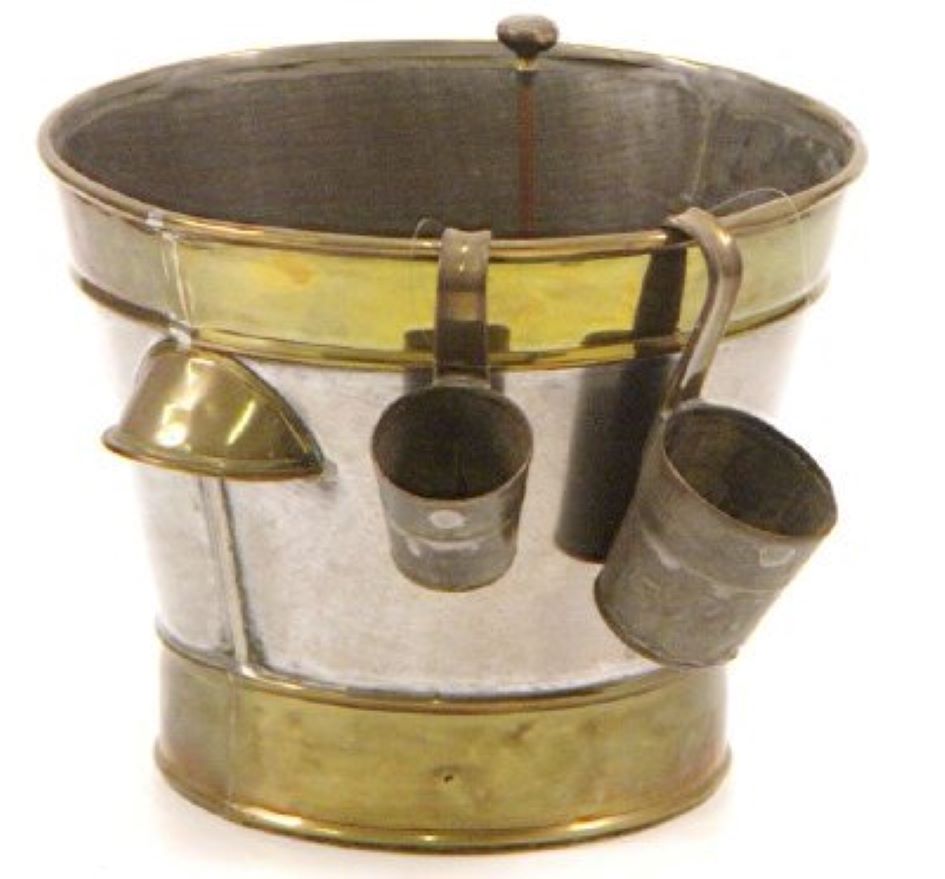
Counter Sales Pan
Dating to the late 19th century, this milk counter pan displayed milk for sale at St John’s Dairy in Reading. It holds 20 pints of milk and comes with three utensils. Cream floats to the top of fresh milk, and the stirrer would be used to mix it back together. Meanwhile the measuring spoons would dispense the milk to customers.
Milk shops in this period sought to improve the reputation of the dairy industry. Cows would be visible in the back of the shop to convince customers the milk was fresh, uncontaminated, and not watered down.
MERL 54/358
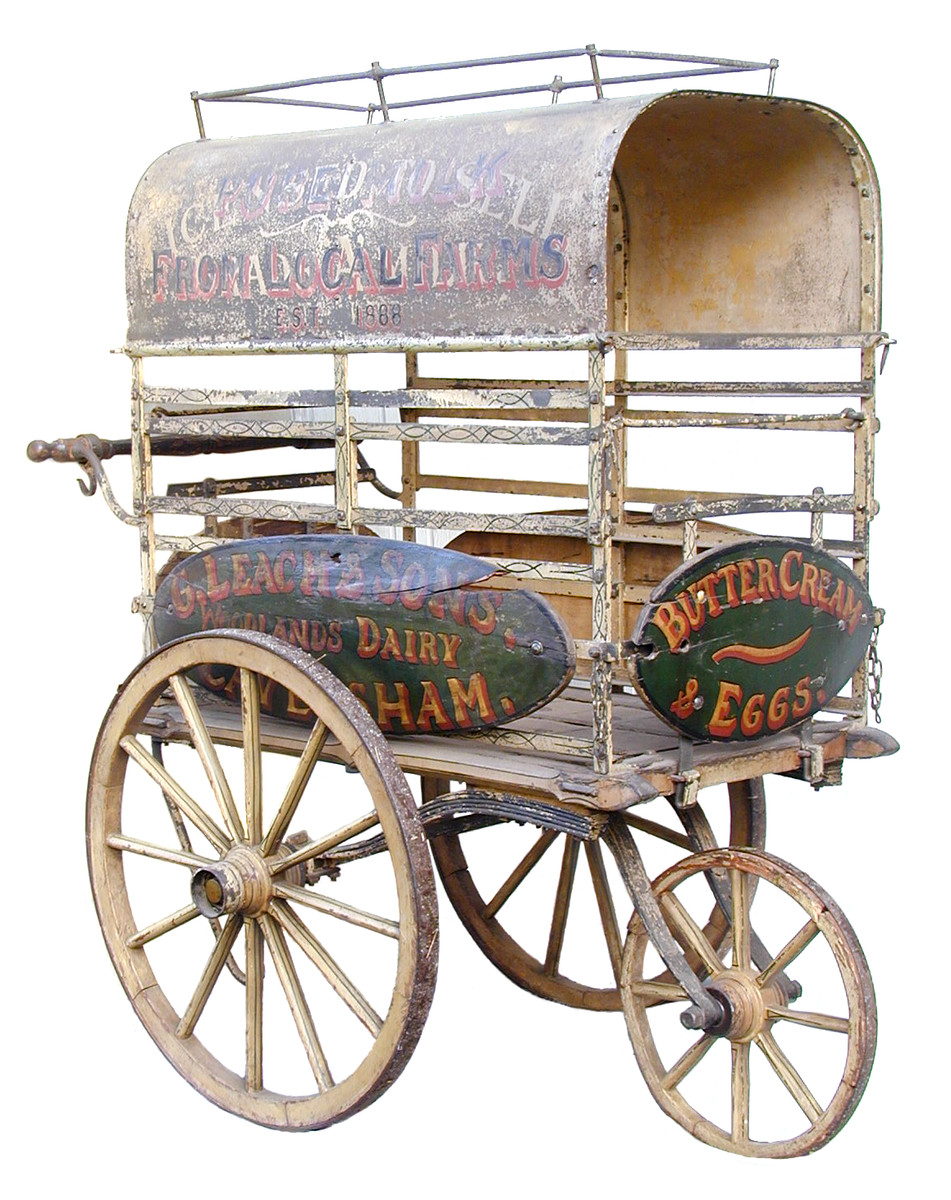
Dairy Cart
This cart – also described as a ‘barrow’ due to its design – was used to transport dairy products for sale. Not every dairy had its own shop, and so carts like these would be used to take produce to market. The name ‘Woodlands Dairy’ is proudly advertised on the side.
In 1925, when this cart was made, demand for dairy produce was sharply increasing. Yearly milk consumption rose from 9 gallons per person in 1861 to 22 gallons in 1931. This was due to new innovations such as pasteurisation and the milk bottle, and the discovery of milk’s nutritional value.
MERL 59/276
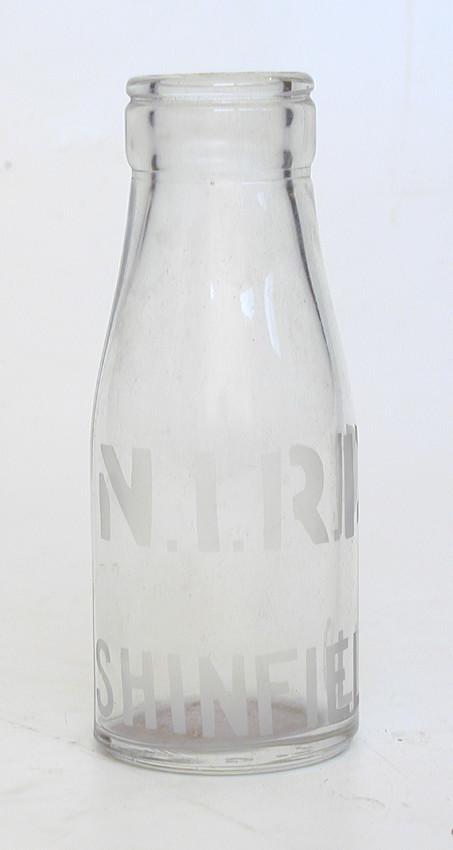
Glass Milk Bottles
Glass milk bottles were first introduced to the UK in the 1880s, and played an important role in the improvement of milk hygiene, ensuring no harmful bacteria could get into the milk after the cap had been secured. They also provided customers with a clear view of the milk, and ensured every customer received the same amount.
94% of milk was sold in glass bottles in 1975, which has reduced to less than 4% today. This can be attributed to a decline in home milk delivery. This bottle was used at the National institute for Research in Dairying in Shinfield.
MERL 96/18/19
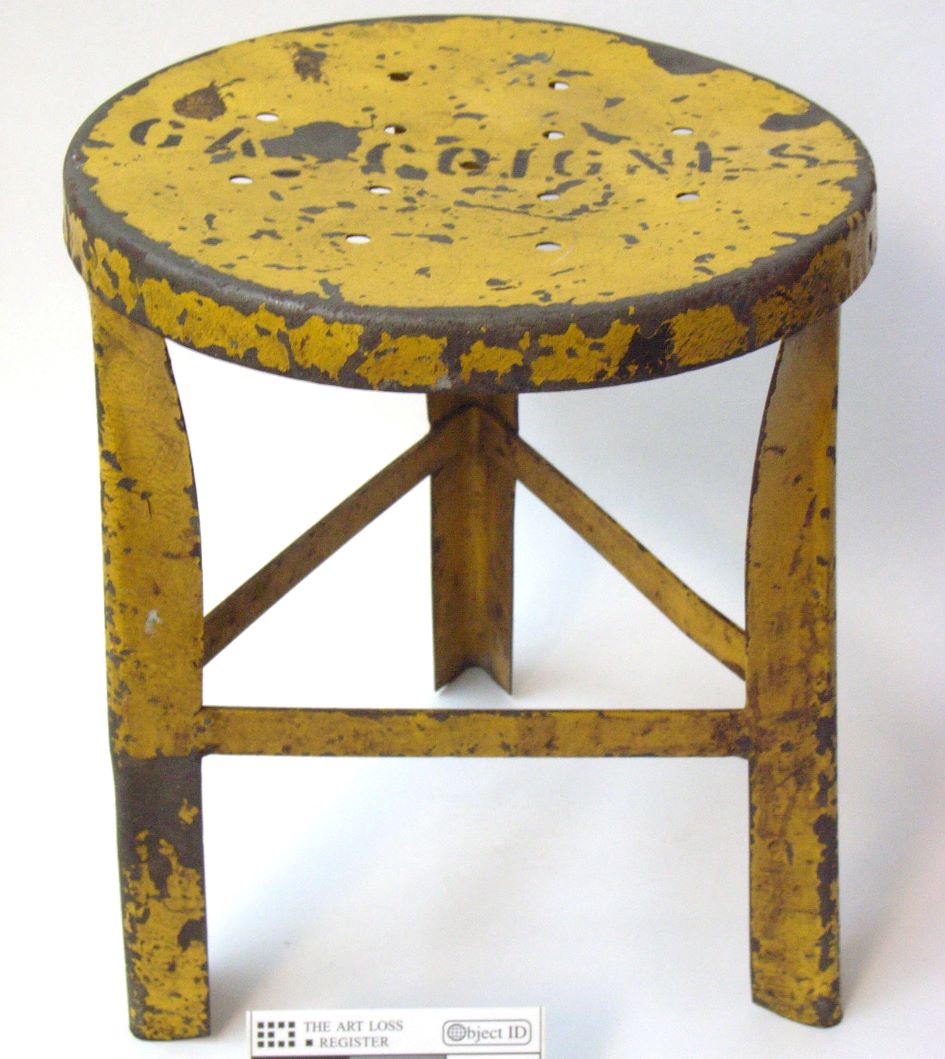
Milking Stool
Until the end of the 19th century, milking stools were an essential piece of kit for a dairy farmer, as they would spare the farmer’s knees when squeezing milk from a cow’s udder.
Humans began drinking cow’s milk around 8000 years ago, despite the fact that all adults were lactose intolerant at the time. It was likely first tried by people who would have otherwise starved. Over the years, genetic mutations resulted in the ability to digest milk. However, the process did not have time to fully complete, as many people are still at least partially lactose intolerant today.
MERL 2006/3
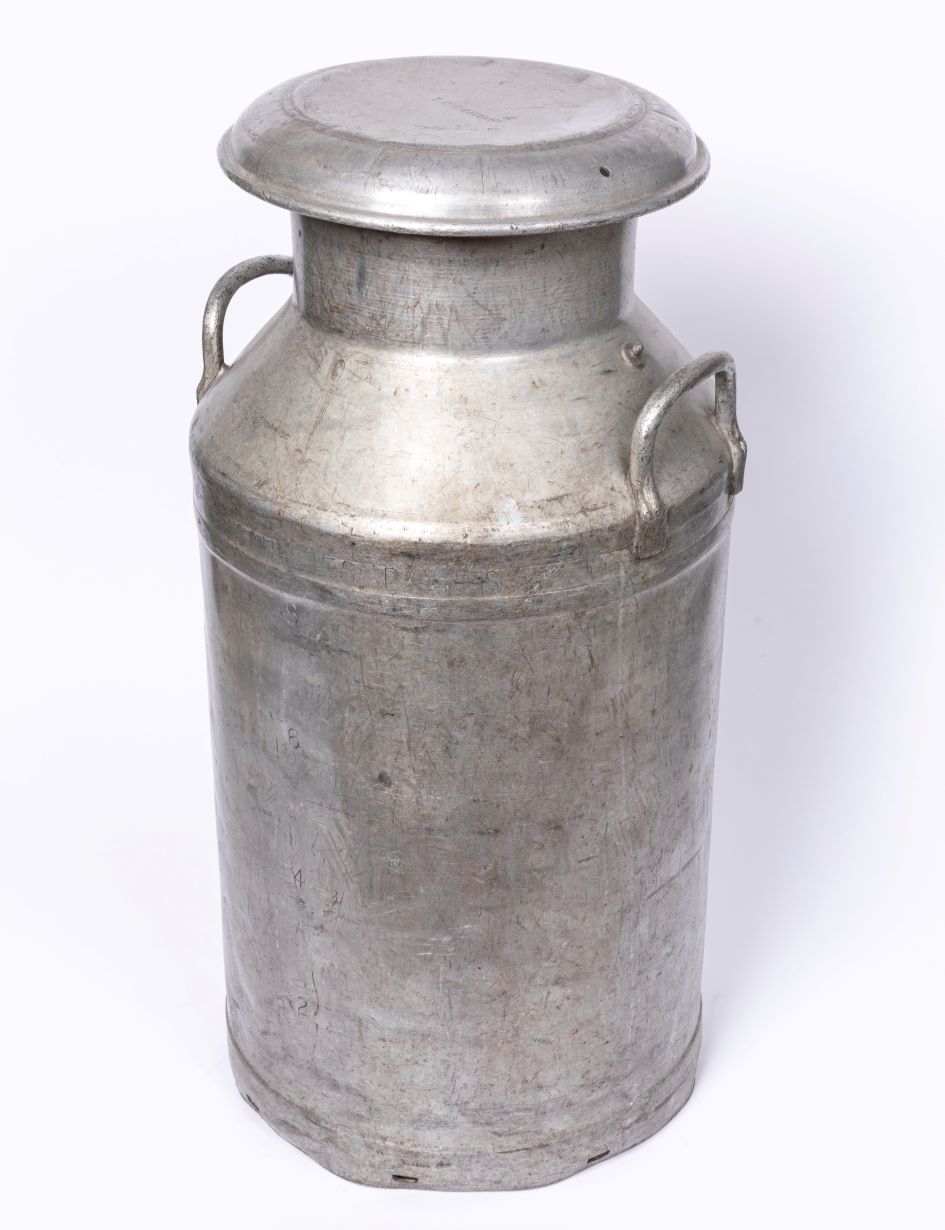
Milk Churn
Used for transporting milk, this churn was used occasionally by a stockbreeder named Joseph Bevan who kept cattle and sheep.
Methods for transporting milk evolved in the 19th century. Previously, urban populations had received milk from cramped cowsheds within the city boundaries. However, the development of railways led to the rise of ‘milk trains’ which could deliver churns of fresh milk from rural dairy farms before it went sour. They continued to grow in popularity into the 20th century, until the Milk Marketing Board switched to road transport in the 1960s.
MERL 2012/431
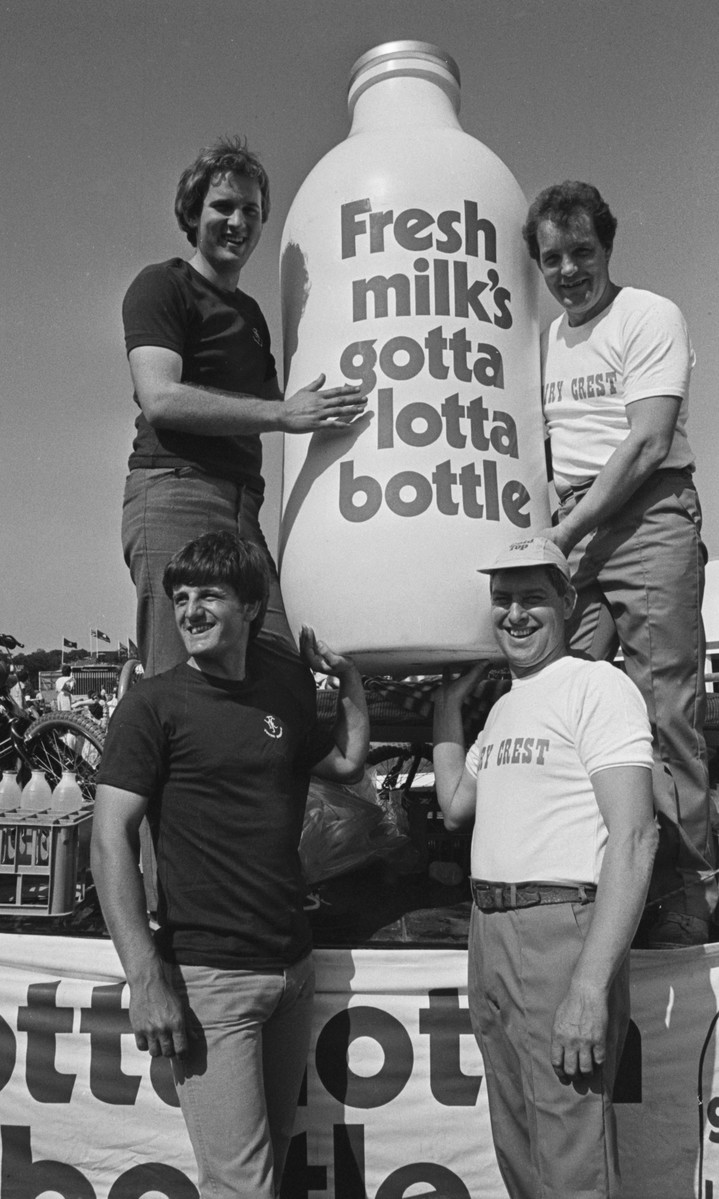
Royal Show Photograph
This photograph, taken by agricultural photographer Peter Adams, shows a display from the 1983 Royal Show. These shows were organized by the Royal Agricultural Society of England to showcase British products and inventions. They frequently attracted over 100,000 visitors, many of them international.
These three men are standing in front of a ‘Food from Britain’ poster. This was a government initiative, established in 1983, to promote British food exports. These exports reached record-breaking levels in 2007, just before the initiative dissolved, suggesting it had been a success.
P PAD A PH1/188/1
Showing Progress case
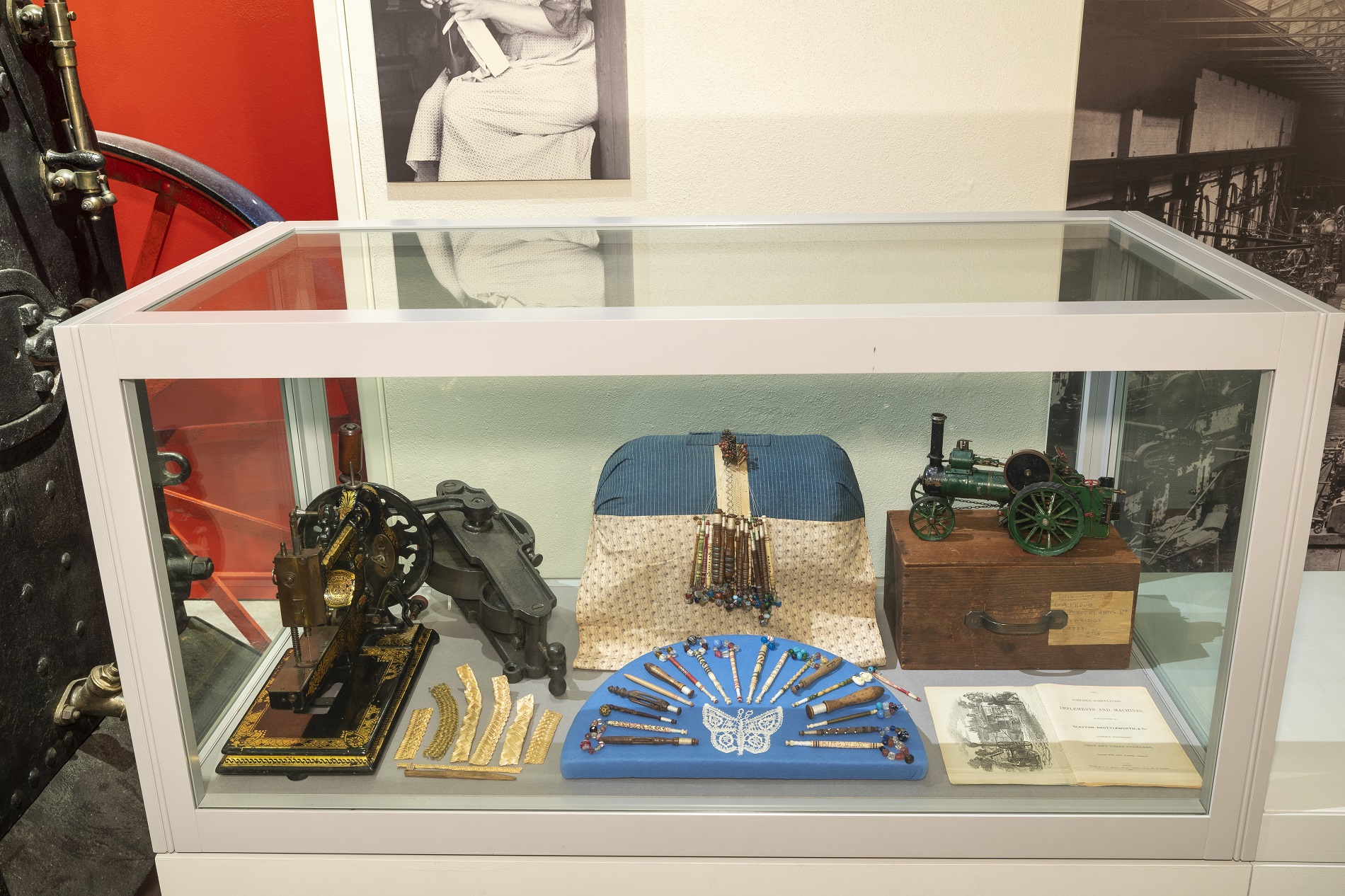
Showing Progress case
Sewing Machine
Straw Plait Samples
Lacemaking Pillow
Traction Engine Model
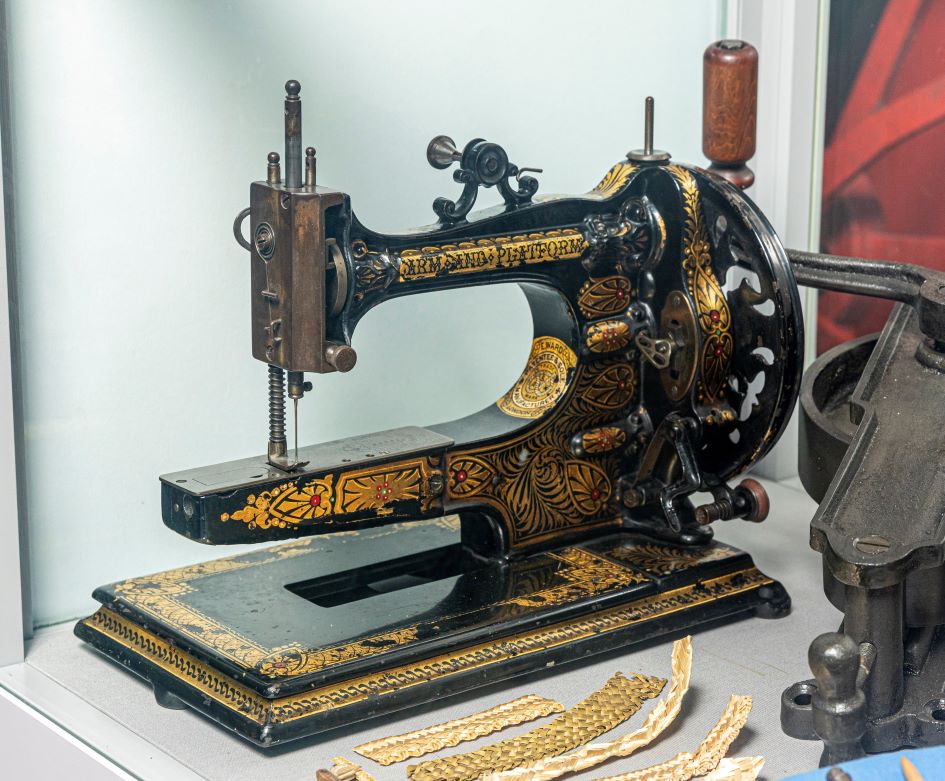
Sewing Machine
Known as Edward Ward’s ‘Arm and Platform’ machine, this hand sewing machine was recommended for professional tailoring or domestic use. It was made between 1880 and 1892.
Although sewing has been a staple of domestic life for 20,000 years, the mechanisation of the process was not attempted until the 18th century. After many unsuccessful attempts, Frenchman Barthelemy Thimonnier invented the first working machine in 1830. Incensed by the threat of unemployment, a group of tailors burned down his factory. Thimonnier barely escaped with his life.
MERL 81/63
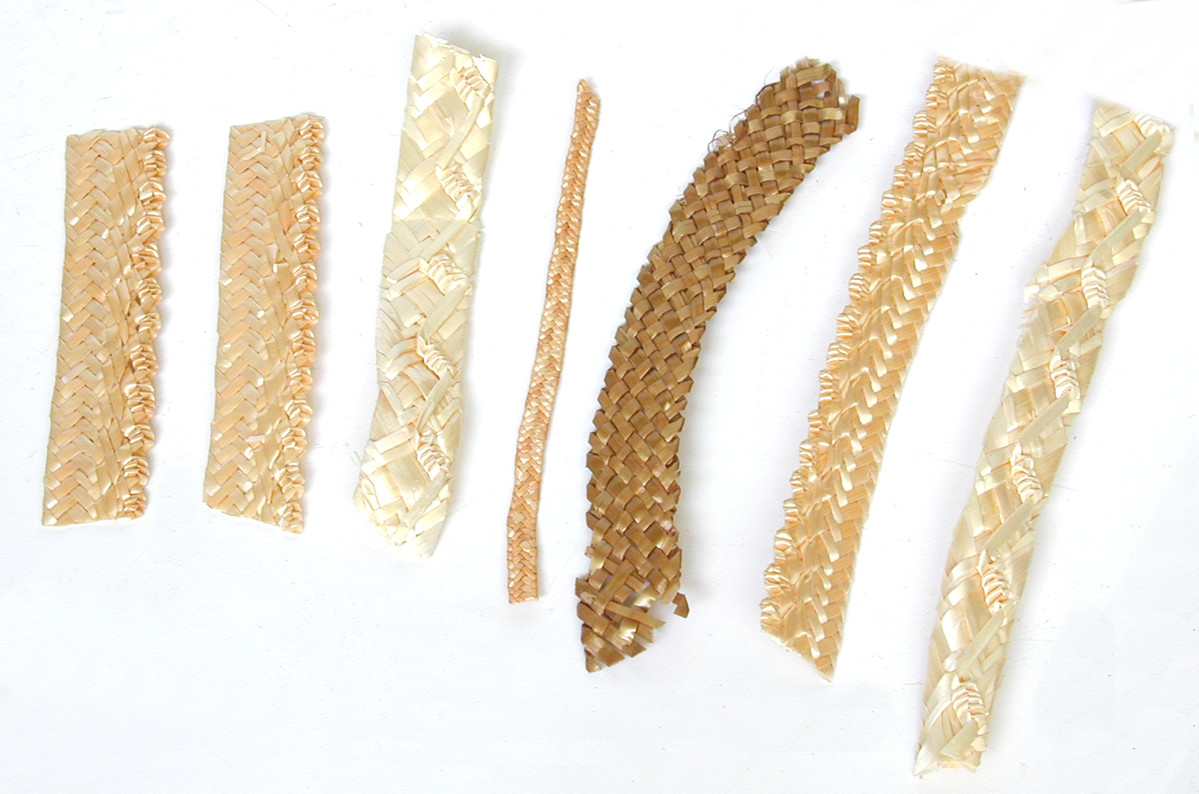
Straw Plait Samples
These seven samples of straw plaiting show various designs. Some of the straw comes from China and Taiwan.
Straw plaiting is the technique used to create corn dollies, which are pagan figures or tokens. Traditionally, these would be plaited from the last sheaf of corn harvested from a crop, and kept in a place of honour in the home to ensure the next harvest germinated. Dollies are still important cultural objects all around Europe. For example, the Swedish Yule goat is typically woven from straw.
MERL 86/201
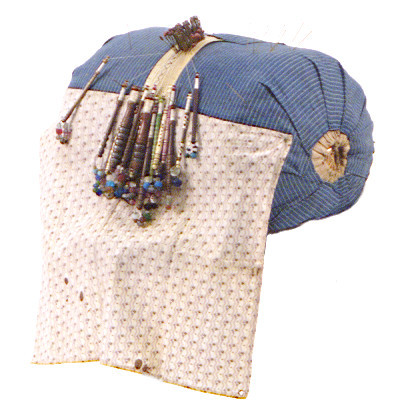
Lacemaking Pillow
Lacemaking pillows were used to pin patterns to, stick pins into, and lie bobbins on. This pillow also comes with a ‘drawter’, which is a cloth to keep the lace clean, and a ‘worker’ which protects the pillow when not in use.
Lace originated in the early 16th century, probably in Venice, and rapidly became the height of fashion in Europe. The elaborate ruffs and collars that denoted high social status demanded equally complex lacemaking techniques. By 1870, machine made lace dominated the market and could replicate almost every type of handmade lace.
MERL 51/128
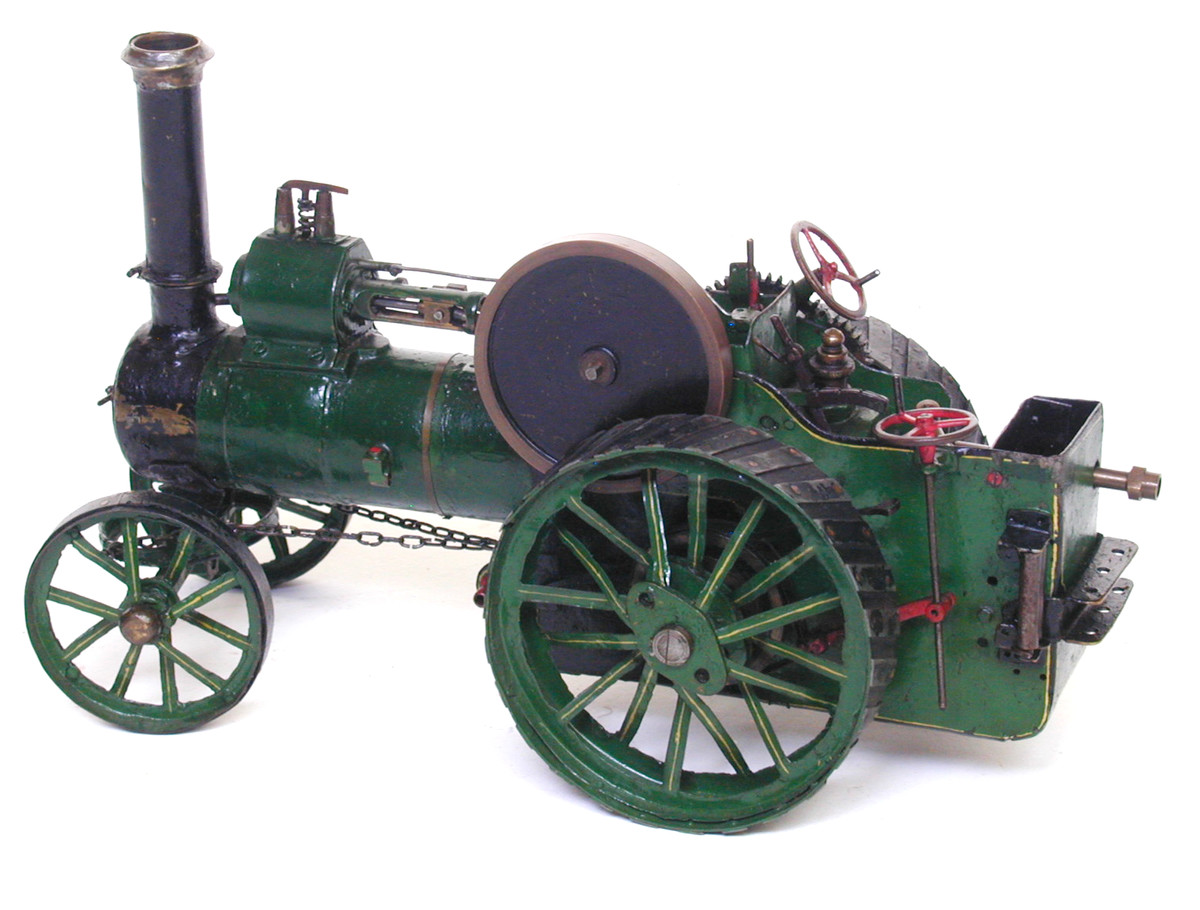
Traction Engine Model
Made by 16 year old George Froud in 1921, this traction engine model is fully working; it is fuelled by injecting the brass pole at the rear. It was presented to the MERL by the Vickers Armstrong model club in 1963.
Traction engines are mobile steam engines which became popular in the latter half of the 19th century. Though they did not fully replace horse power, they undertook a number of agricultural tasks. For example, the agricultural general purpose engine was a versatile machine used for tree pulling and threshing.
MERL 63/180
Village Idyll
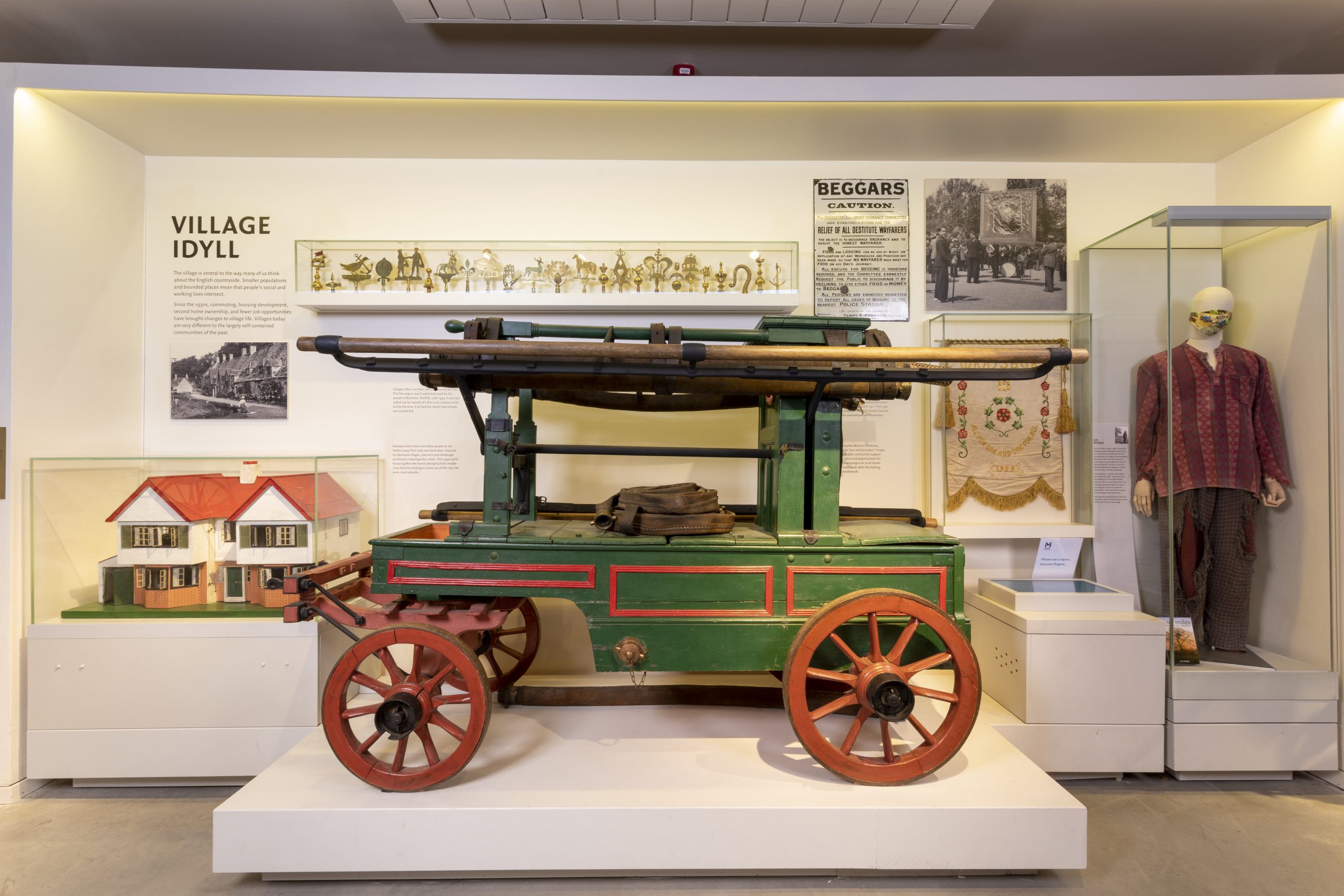
Village Idyll
Vagrancy Sign
Fire Engine
WI Banner, Wraysbury
Doll's House
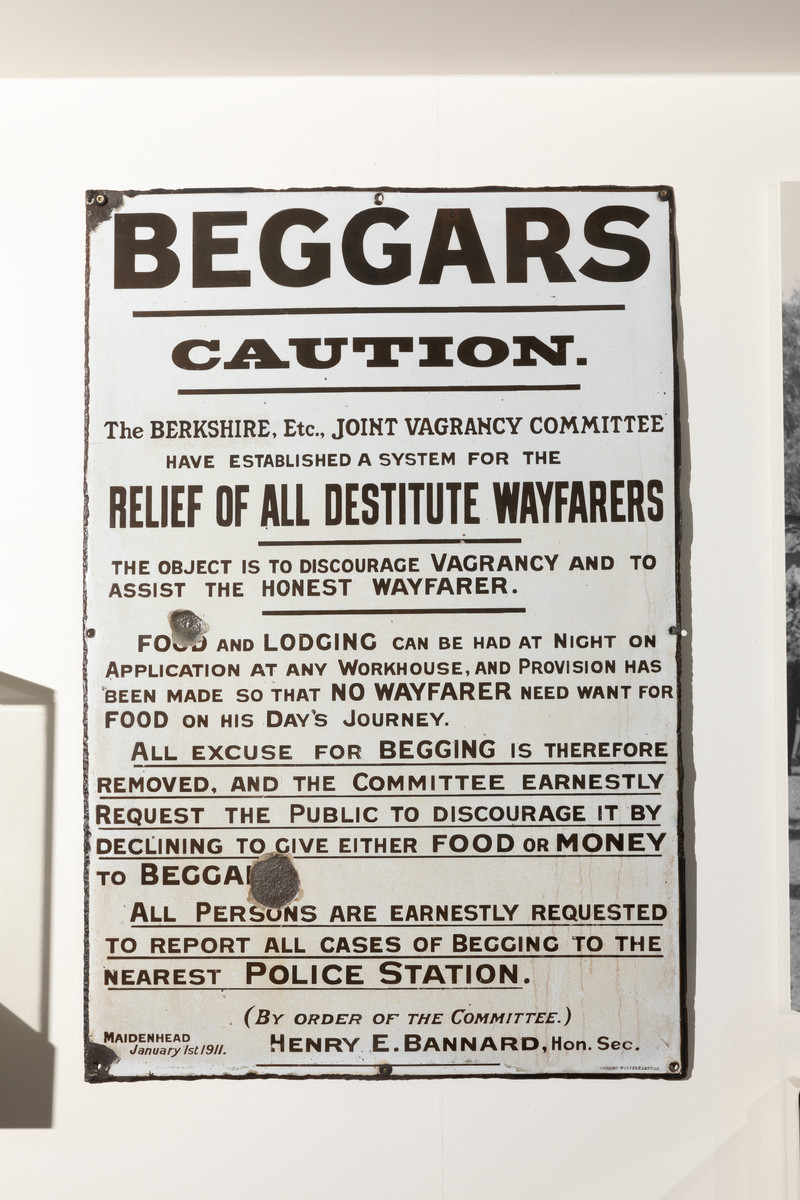
Vagrancy Sign
This sign was issued by the Berkshire Joint Vagrancy Committee in 1911 to deter beggars whilst offering food and rest to those in need. The idea was to offer a better alternative to vagrancy, much like the workhouses of the Victorian era.
Vagrancy first became an offence in 1349 follwing the Black Death, where there was a massive shortage of workers so the crime of ‘idleness’ became a punishable offence.
MERL 60/173
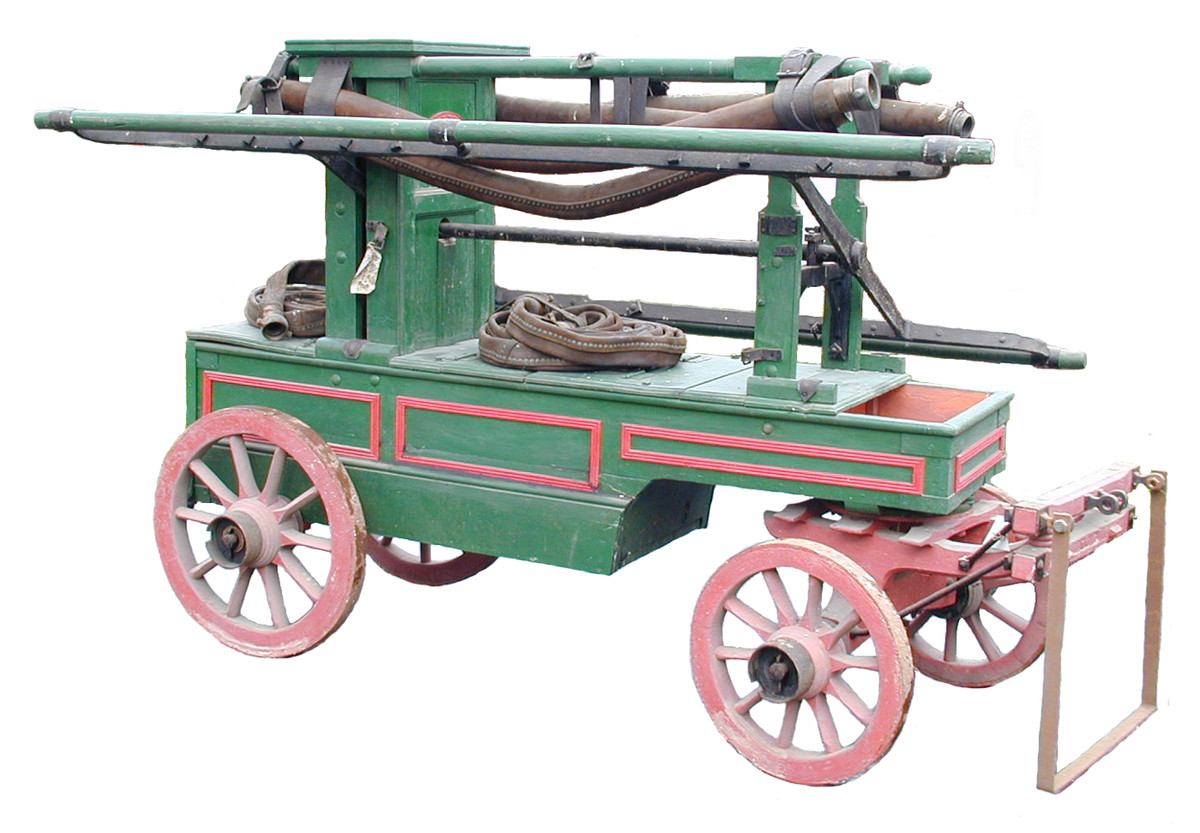
Fire Engine
This is a one horse, two piston wooden fire engine, It was called the ‘Banham Subscription Fire Engine’ and was funded by the parish. It was worked by 12 men and was known as a ‘double sixer’. The engine was made by Tilley (later Shand Mason) of Blackfriars Road, London, in 1839. It was in use in the village of Banham until 1934. If the engine was not used during the year it was the responsibility of the chief engineer every Good Friday to get the engine out to the village pond and there to test it with the help of a total of twelve men.
The last time the engine was used in practice was in 1930 when it was hauled out to douse a fire in an “old man’s lavatory”. After much struggling it arrived at the scene of the conflagration only to find that the fire had been quenched by the aforesaid old man, who explained the he had put it out with a bucket of water.
MERL 51/410
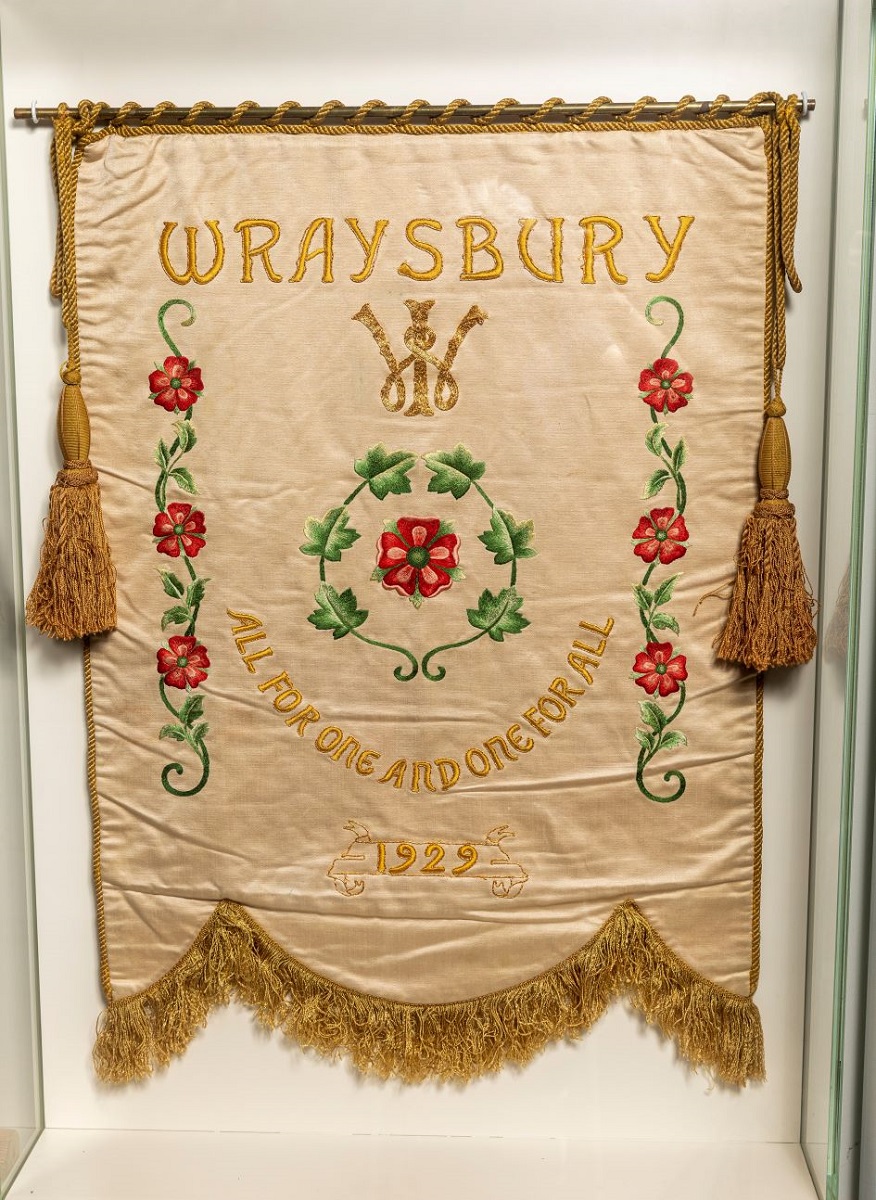
WI Banner, Wraysbury
This is one of a set of five Women’s Institute (WI) banners, this example relating to Wraysbury WI. This particular banner also features a stand and bag. It includes a pattern of roses, with the date 1929 and motto, ‘All for One and One for All’ embroidered in gold thread. The banner was made by founder member of Wraysbury WI Miss K. Burke in the early 1930s, although every member of the group was encouraged to contribute stitches.
Every individual WI meets at least once a month and there is usually a speaker, demonstration or activity at every meeting for members to learn and develop a range of different skills. Craft has always played an important role in the WI and thousands of members are involved in a range of different crafts.
MERL 2007/47/1
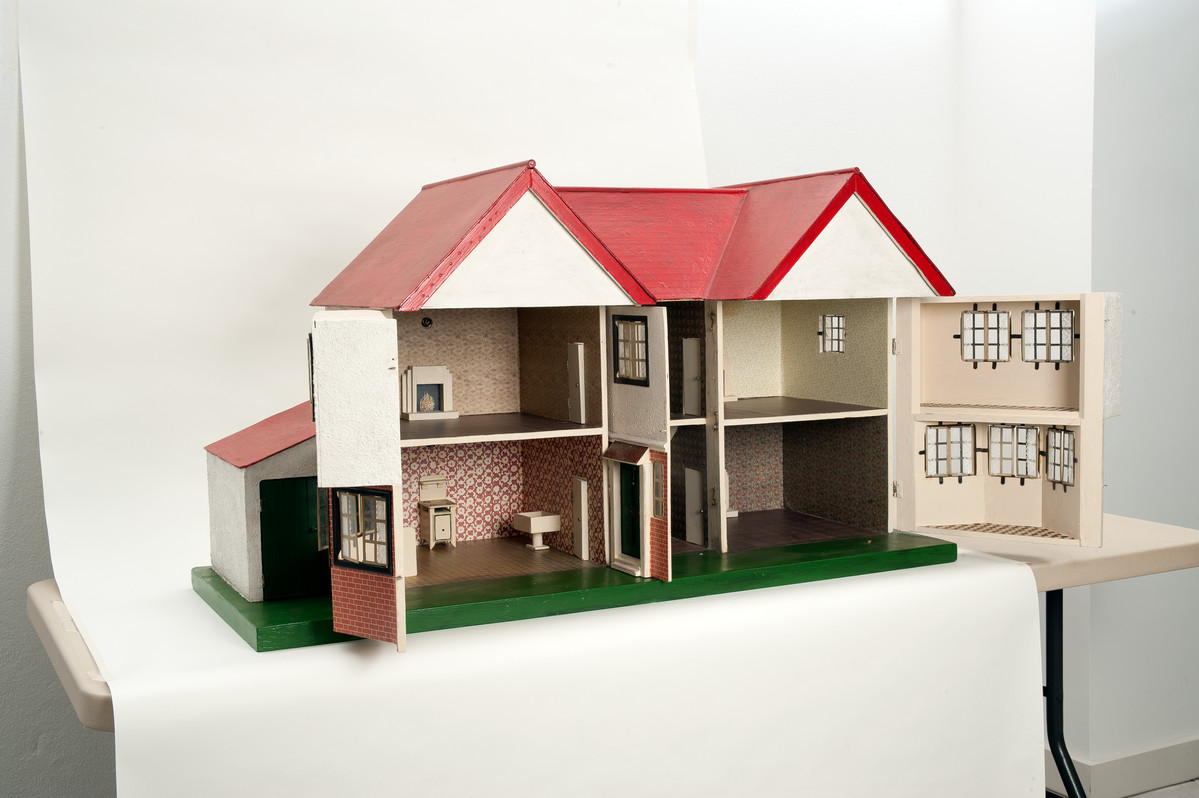
Doll's House
This Doll’s House was created by Tri-ang Toys. The design imitated the popular mock Tudor design of suburban houses in the 1930s, as suburbanisation grew throughout the decade. This doll’s house shows how deeply embedded these aspirations and desires were, as they became reflected in children’s play. Toy houses were also made with a modernist design but the mock Tudor models were far more popular.
MERL 2008/94
Into the Country - Display
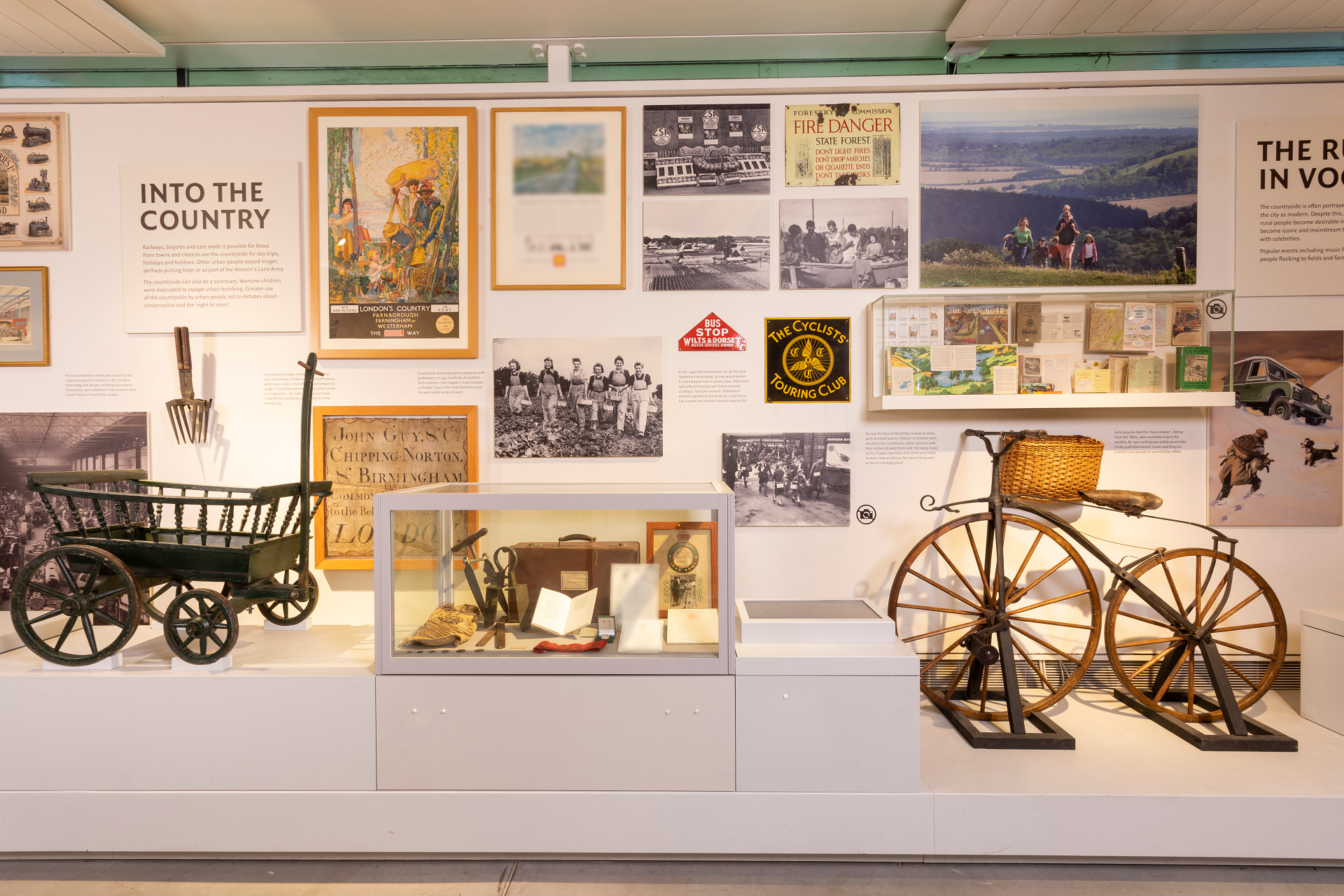
Into the Country - Display
Hand Pulled Hop Wagon
Bus Stop Sign
Forestry Commission Sign
Bicycle

Hand Pulled Hop Wagon
This small push cart originally came from Brenchley, Kent, and was made by a wheelwright in the hop growing district of South East England in the mid nineteenth century.
Such push carts, known as ‘Brindley Hop Wagons’, were used by women who worked in the hop fields: they were made deep so that the carts could be filled with hops, with children sitting on top of the load. At the time of acquisition in 1956, a 70 year old wheelwright in Wadhurst commented that he remembered his father making and repairing them, but their use was already declining when he was a child.
MERL 56/308
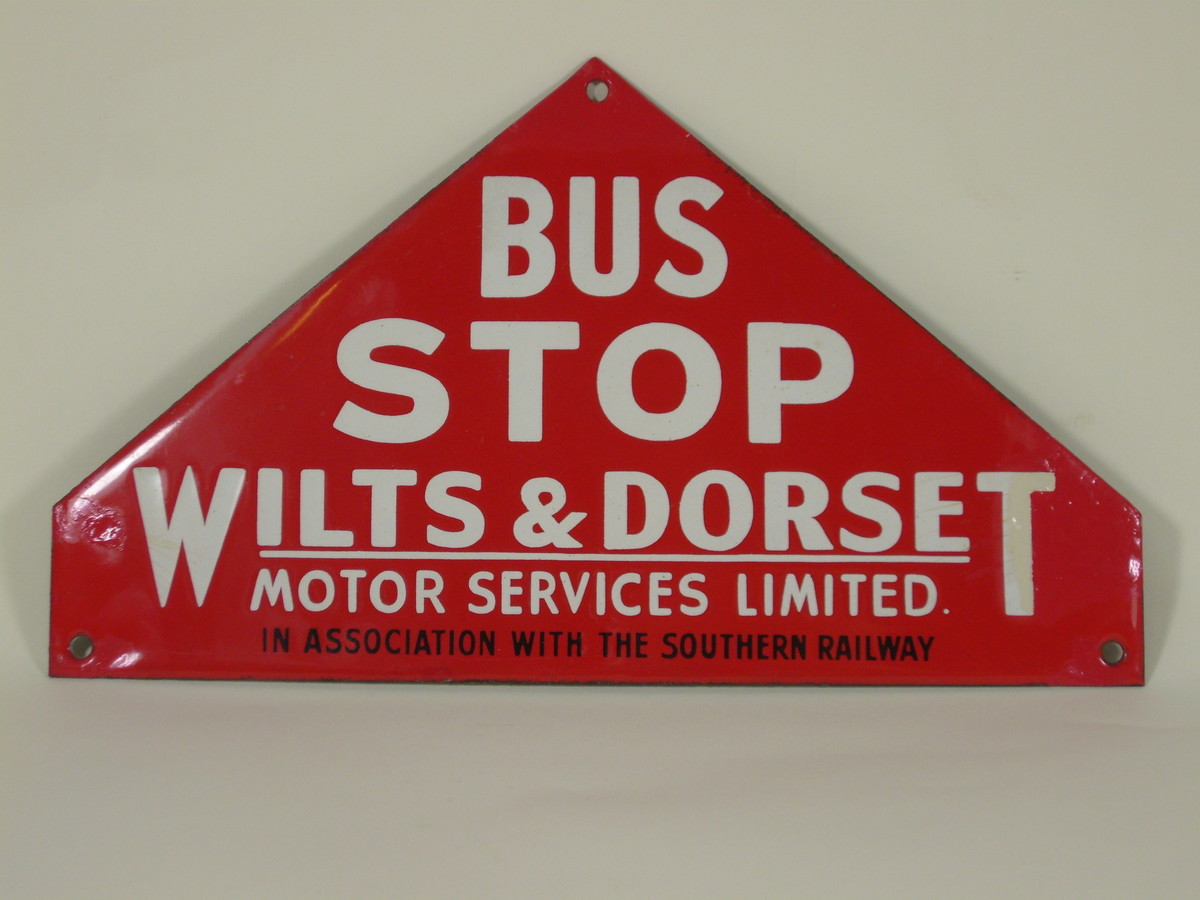
Bus Stop Sign
This enamel sign dates from the 1930s. Southern Railway bought shares in the Wilts & Dorset Bus Company in 1931. With the nationalisation of the railways in 1948, the Wilts & Dorset became state owned. It ran buses in Wiltshire, Dorset and Hampshire, especially in the Andover, Amerbury, Pewsey and Salisbury areas.
MERL 2010/131
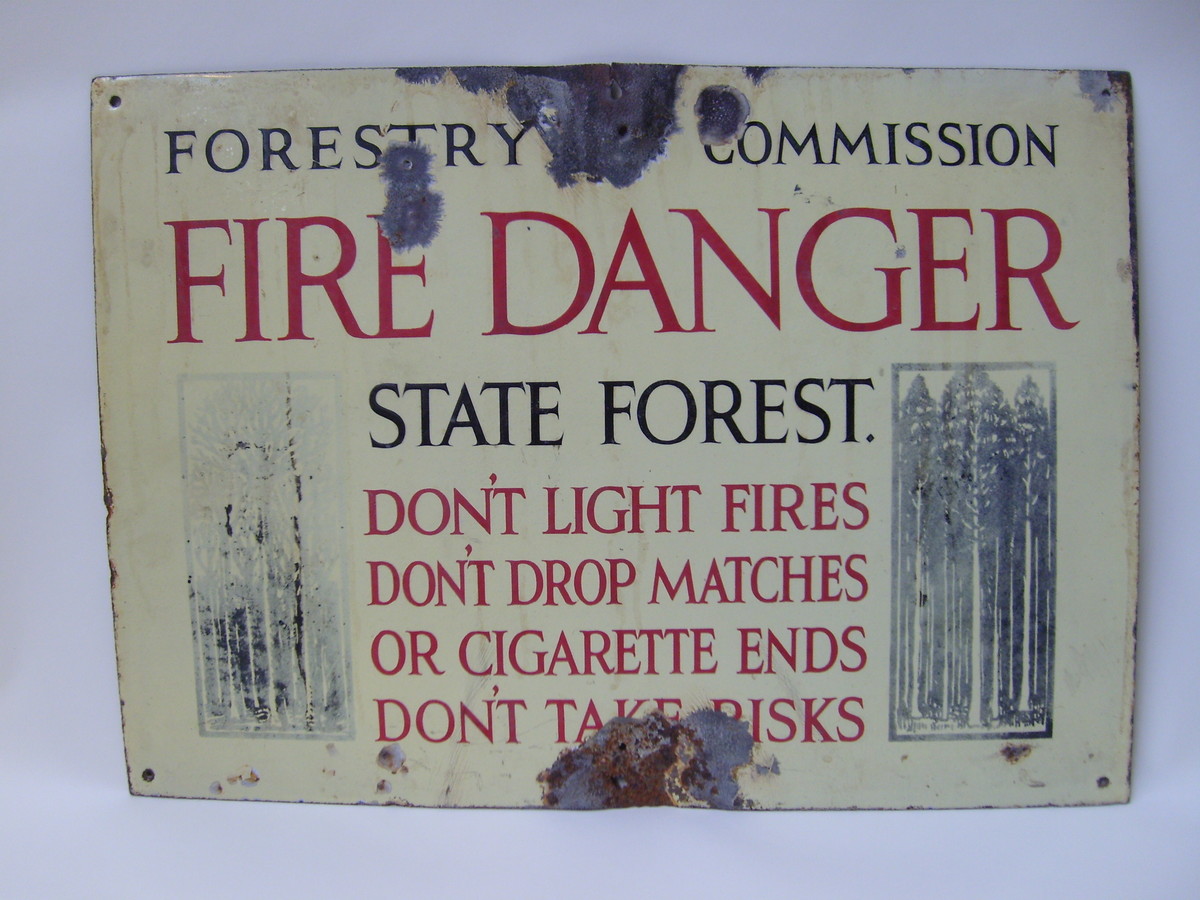
Forestry Commission Sign
This sign dates from the 1960s when the public were given the ‘right to roam’ in Forestry Commission forests. The Forestry Commission was created by the Forestry Act of September 1919, to rebuild and maintain a strategic timer reserve.
MERL 2010/60
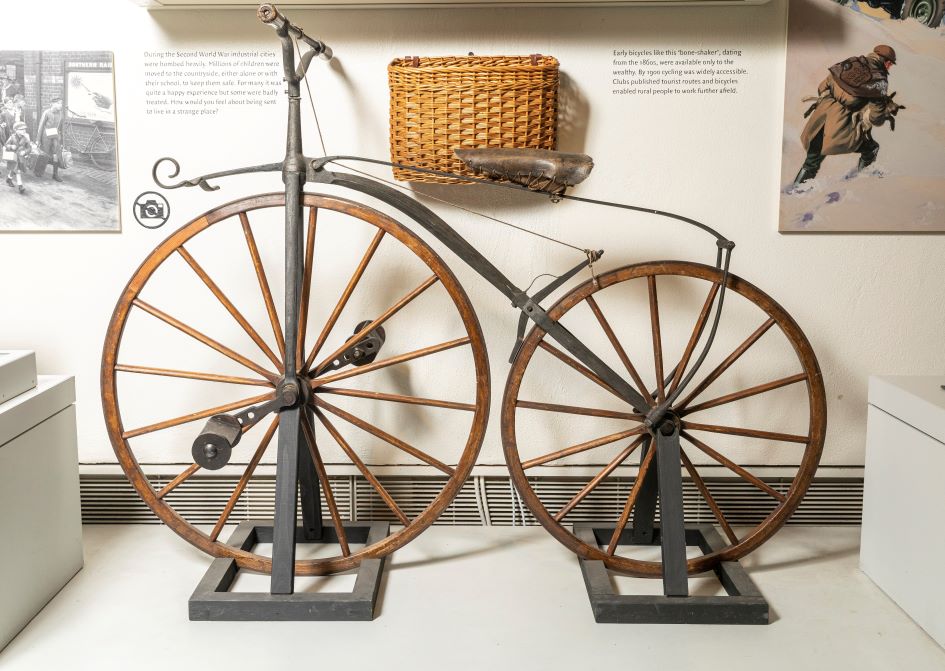
Bicycle
This is an example of a ‘boneshaker’ or ‘velocipede’, a very early bicycle designed in 1865. It consists of a wooden frame mounted on two wooden iron-tyred wheels, with a seat, handle and brake on the rear wheel. It was given to the donor by Dame F. H. L. Clayton-East of Hall Place in Hurley, Berkshire, where it was used to cycle around Hall Place Park. Bicycles such as these were not allowed on the road at that time.
MERL 55/278
Into the Country Case
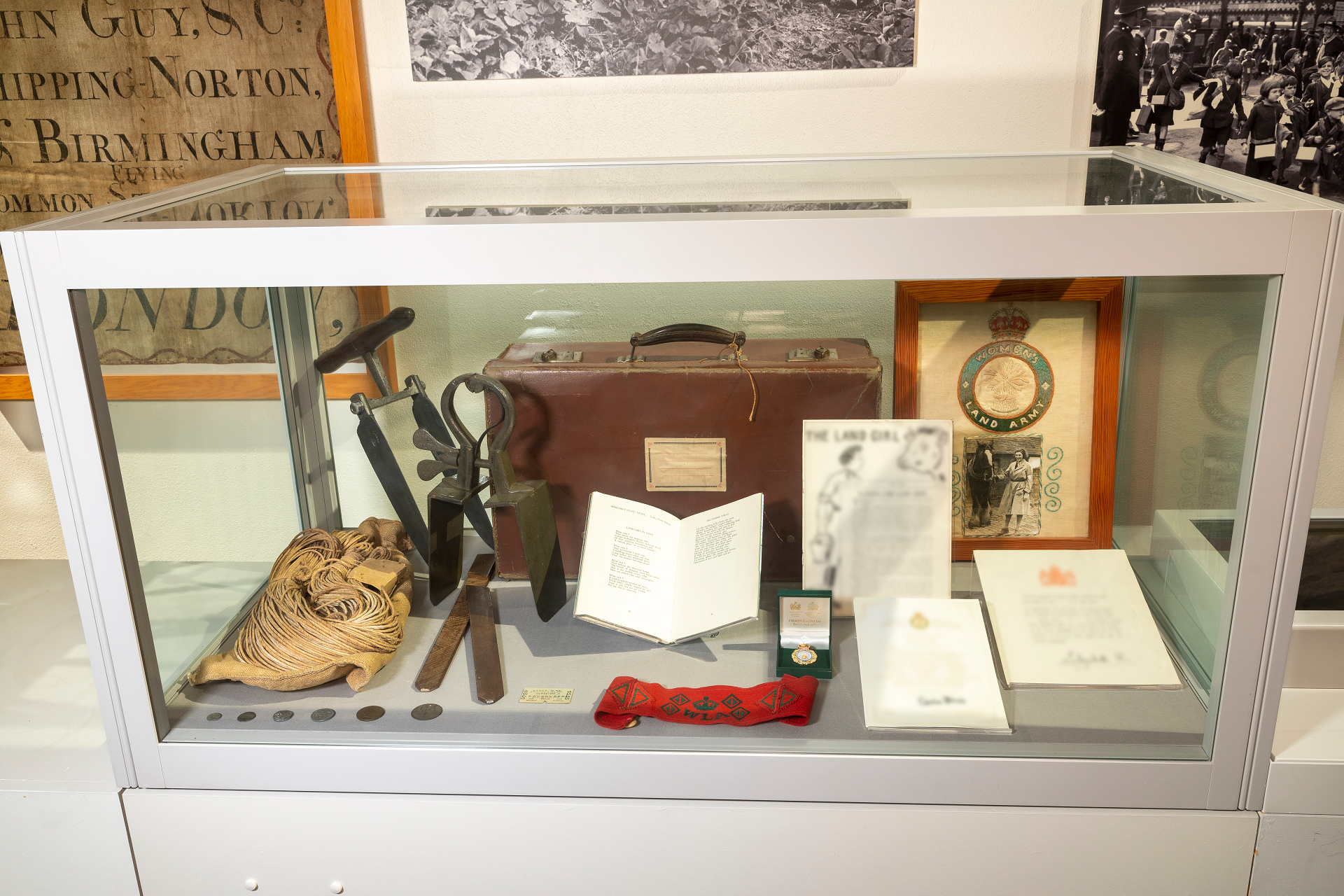
Into the Country Case
Hop Tokens
Evacuee Suitcase
Railway Ticket
WLA Armband
WLA Embroidery and Photograph

Hop Tokens
Hop tokens were given to pickers as their baskets were measured and emptied. Payment was made at the end of each week according to the number of tokens each picker possessed. One token, which is a thin piece of metal 1 inch in diameter, has the letters ‘J.M.’ stamped on it and came from Hereford.
MERL 54/128
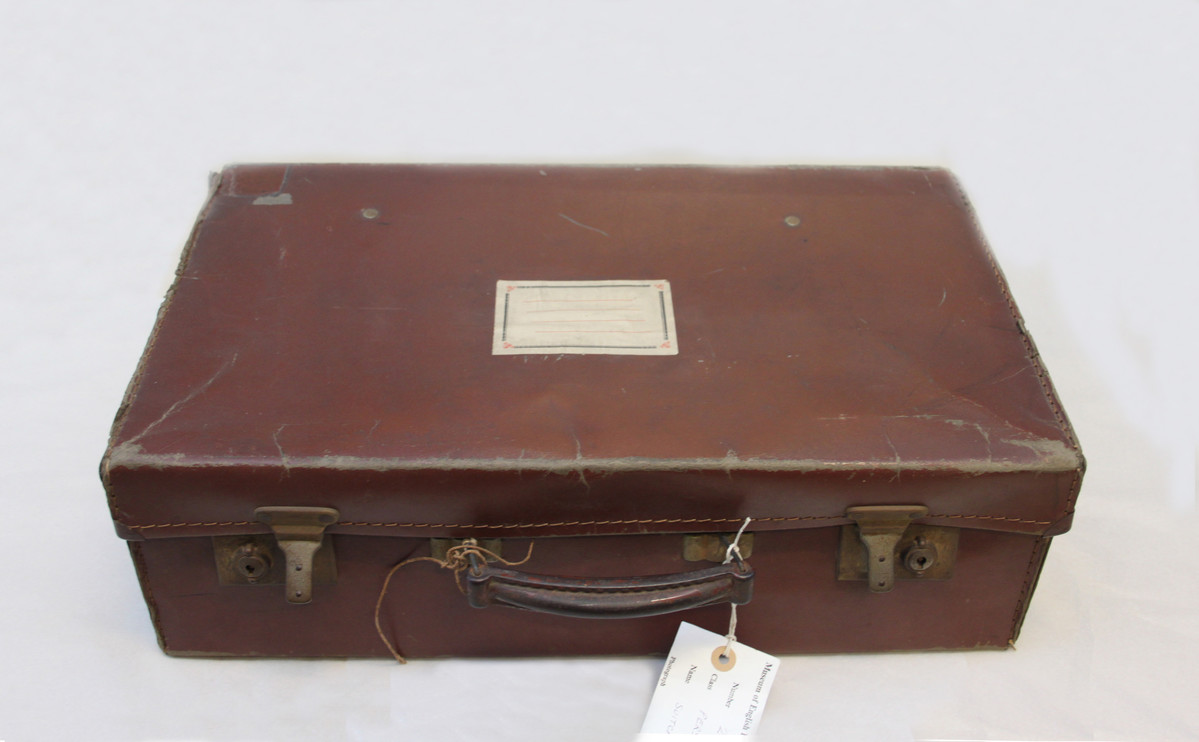
Evacuee Suitcase
This small suitcase is of the type used by evacuee children during World War II. On the 1st of September 1939 evacuated children arrived in Reading. These were children mainly from South West London, Lambeth, Battersea and Wandsworth. London was a city that suffered with pollution and many of the children may have felt a very strong difference in the City to the countryside town of Reading.
MERL 2008/88
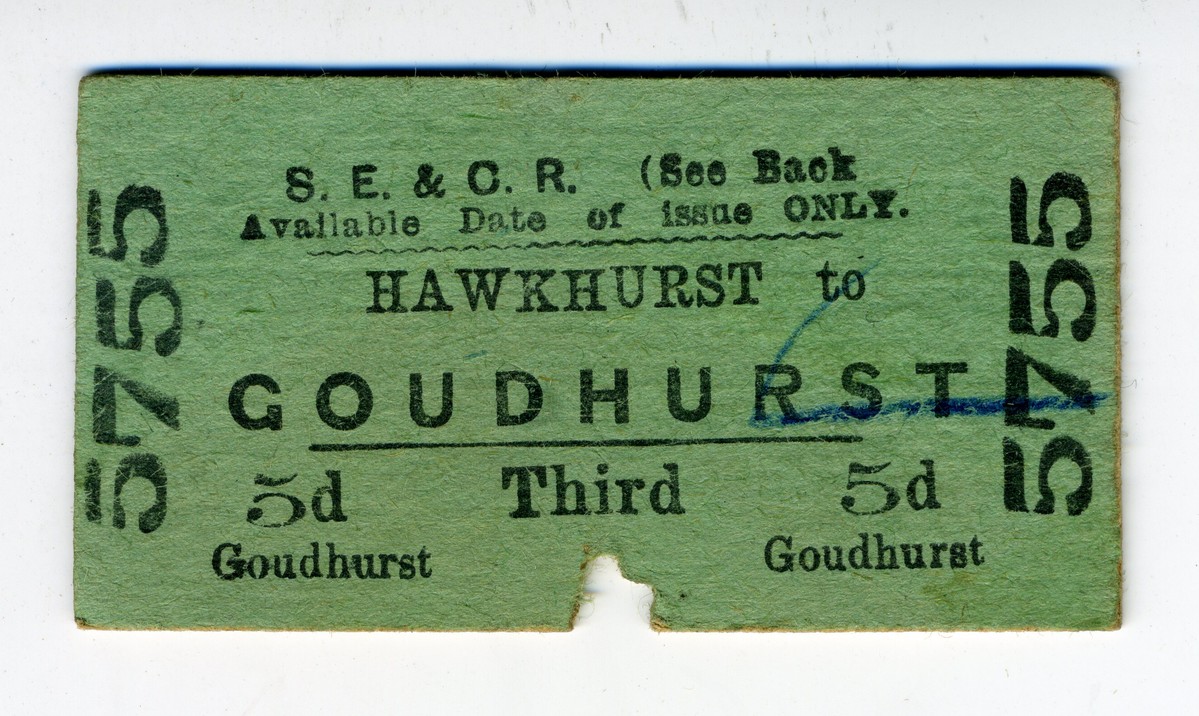
Railway Ticket
This is a railway ticket, costing five pence, for third class travel between Hawkhurst and Goudhurst stations in Kent. It is printed on green card, has been punched, and is dated 4 January 1907. It was issued by South East and Chatham Railway.
The Hawkhurst branch line, an 11 mile single track line, was opened in 1893 and closed in 1961, and linked Hawkhurst to Cranbrook, Goudhurst, Horsmonden and Paddock Wood. One reason for the light traffic on the line, apart from its very rural nature, was that the stations were inconveniently placed. Hawkhurst station, for example, was over a mile from the centre of the village and technically not in Hawkhurst at all. At hop and fruit picking time the line was busier, but by the 1950s competition from road transport was rising fast.
MERL 2010/45
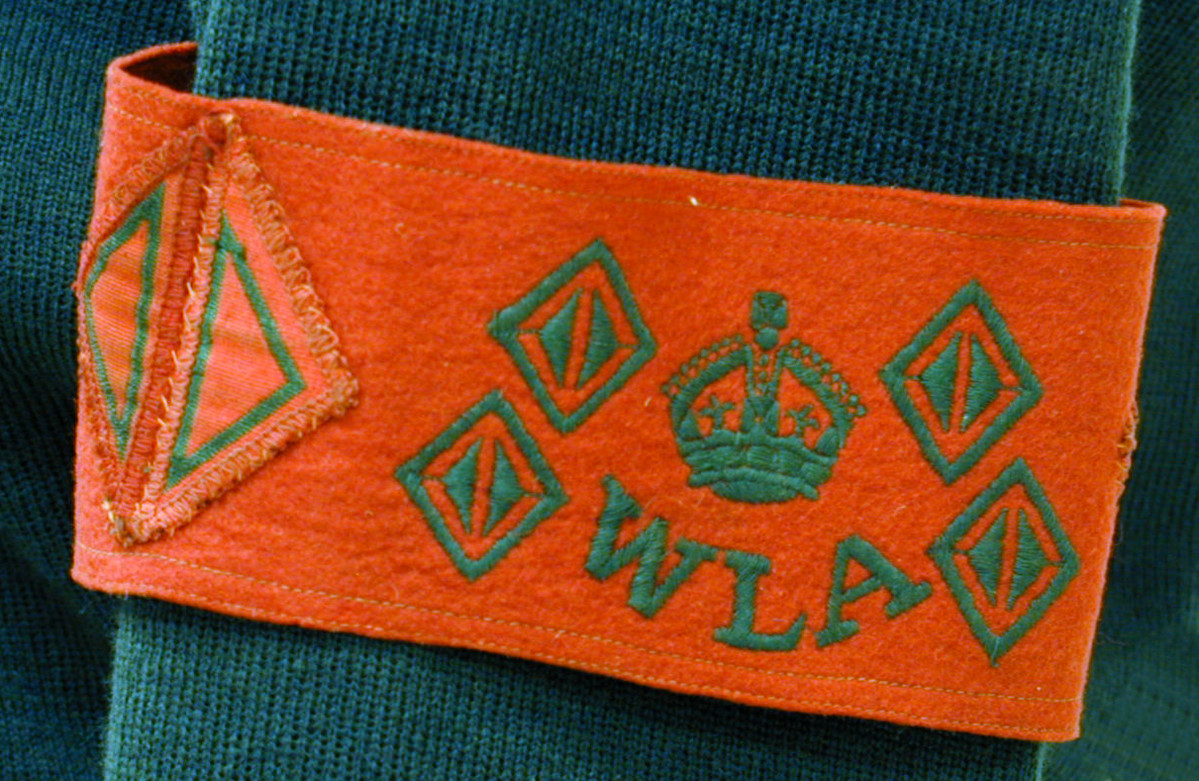
WLA Armband
This is a long service armband issued by the Women’s Land Army to Doreen Thorp. It has a green crown, green letters (W.L.A) and four small green diamonds. Also stitched on it are four red half diamonds outlined in green. Each half diamond was awarded for six months satisfactory service with the Women’s Land Army. The armband represents six years service.
Doreen recalls: “In September 1939 I joined the Women’s Land Army and in October I started two months training at the Midland Agricultural College in poultry, milking (hand & machine), stock and general farm work.”
MERL 88/62
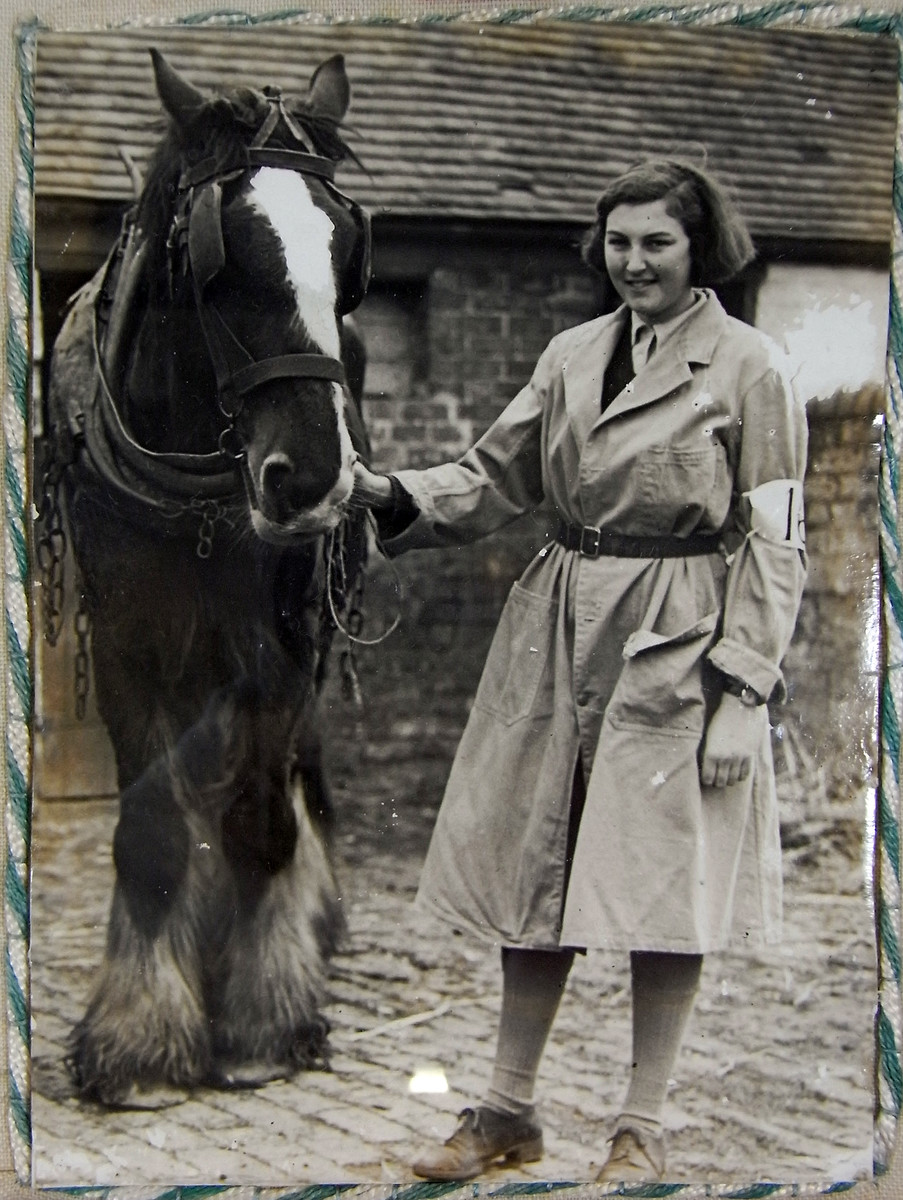
WLA Embroidery and Photograph
The photograph shows Barbara Whitaker, who joined the Women’s Land Army in 1939 at the age of 16. As a farmer’s daughter she knew the work involved and was therefore accepted at a young age. After leaving the Women’s Land Army she carried on farming on a small scale until the 1960s. The embroidery depicts the standard logo of the Women’s Land Army. She worked at Manor Farm, in Southam, Gloucestershire, and also spent her evenings as an ARP ‘Fire Watcher’ and collecting money for the ‘Penny a Week Red Cross Fund’. She left the WLA when it disbanded and received the gold armband from the Queen in person.
MERL 2007/59
Grow Your Own Case
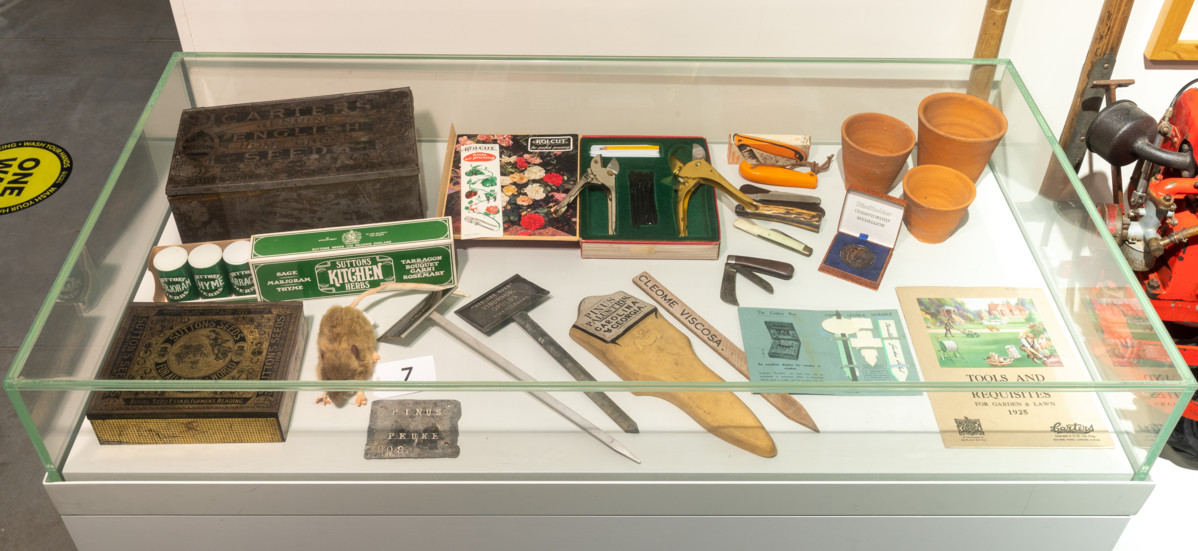
Grow Your Own Case
Budding Knife
Seed Tin
Seed Catalogue
Secateurs
Plant Pots
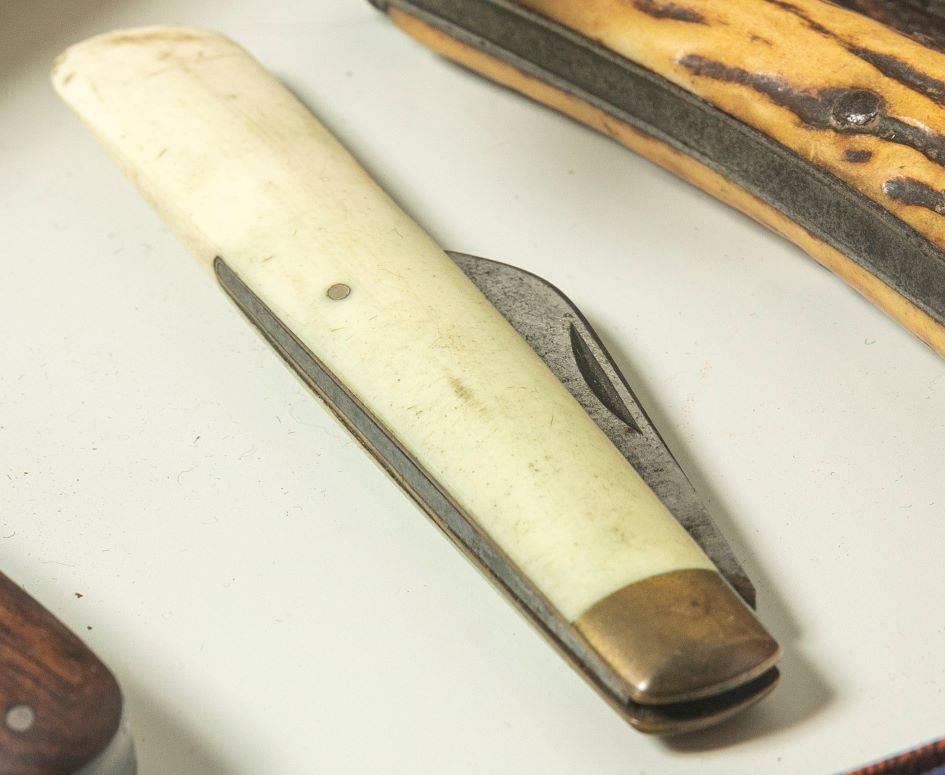
Budding Knife
This is a budding knife, which is used by horticulturalists, florists and botanists to create buds or grafts on plants. This particular knife was made by Raynor of Sheffield and compiled with other rural artefacts by John Cox, who worked for Sutton Seeds from 1931-1976. John Cox started his career as an office boy and worked his way up to Company Secretary.
MERL 2010/101
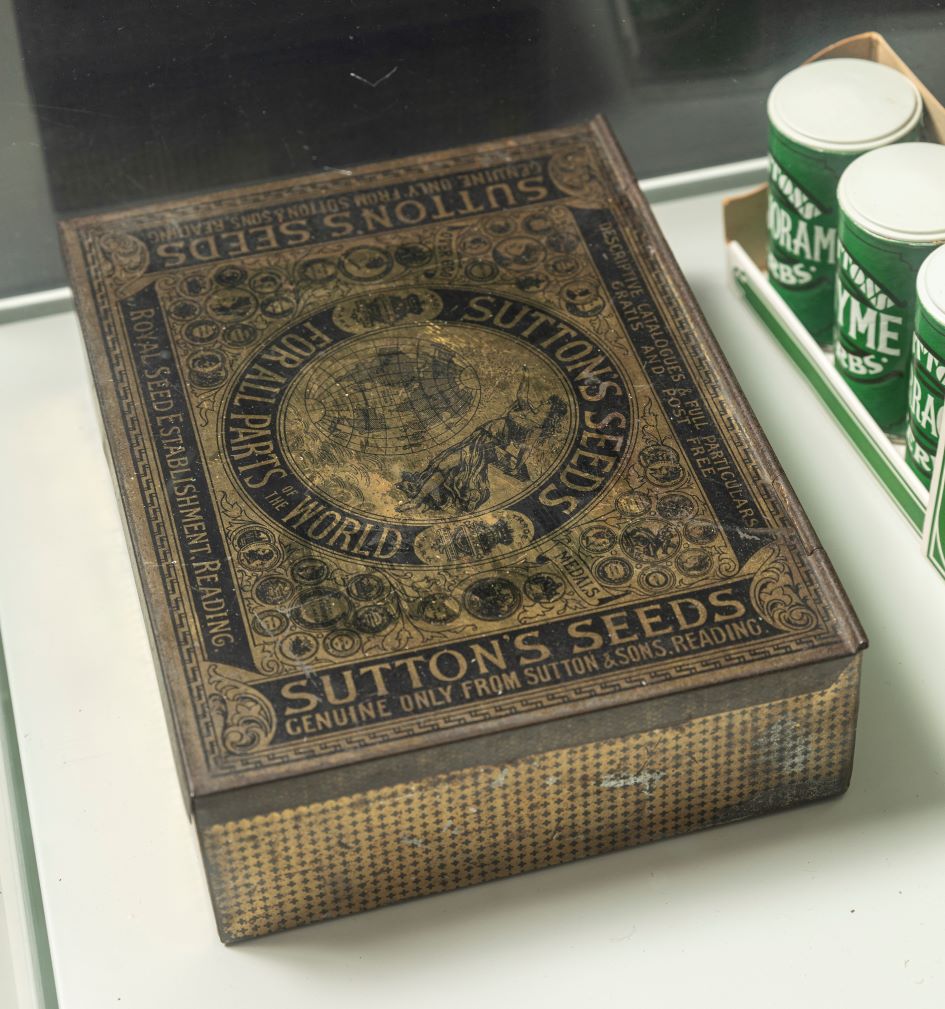
Seed Tin
Suttons Seeds Ltd. was founded in 1806 by John Sutton (1777–1863) and traded as a corn merchant. In 1837 the company moved to Market Place, Reading, expanded into seeds and acquired nursery grounds in Queens Road, Reading. In 1840 they established a testing laboratory and in 1873 new buildings replaced those in Market Place. These included various offices, separate storerooms for different types of seeds and bulbs, recreation rooms, residences and a fire station.
In 1962 Suttons relocated to new grounds and premises on the eastern outskirts of Reading, before moving to Torquay, Devon, in 1976 and then Paignton, Devon, in 1998. The MERL holds records for the company, plus over 100 objects made by Suttons including sacks, signs and seeds.
MERL 2007/10
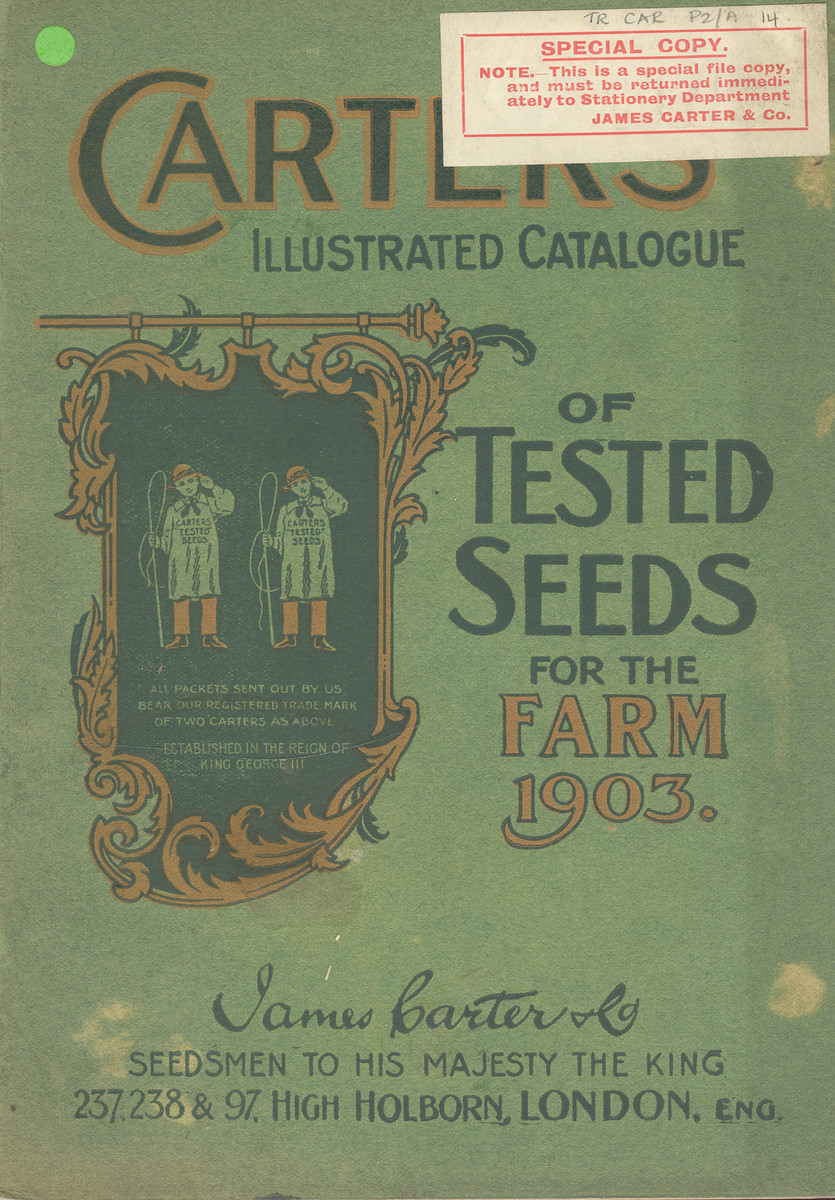
Seed Catalogue
This is a Carter’s Illustrated Catalogue of Tested Seeds for the Farm. The earliest reference to Carters is in an 1804 London directory. However, the first annual catalogue seems to have appeared in 1837, issued by James Carter of 238 High Holborn. A partnership, styled James Carter & Co., was eventually formed including William Herbert Dunnett and Edward John Beale, being continued by these two partners after Carter’s death. James Carter & Co., were highly fortunate in their acquisition of both home and foreign royal patrons who by 1880 included the Queen of England together with the Prince of Wales, the Sultan of Turkey, the King of Portugal and the King of Italy.
TR CAR P2/A14
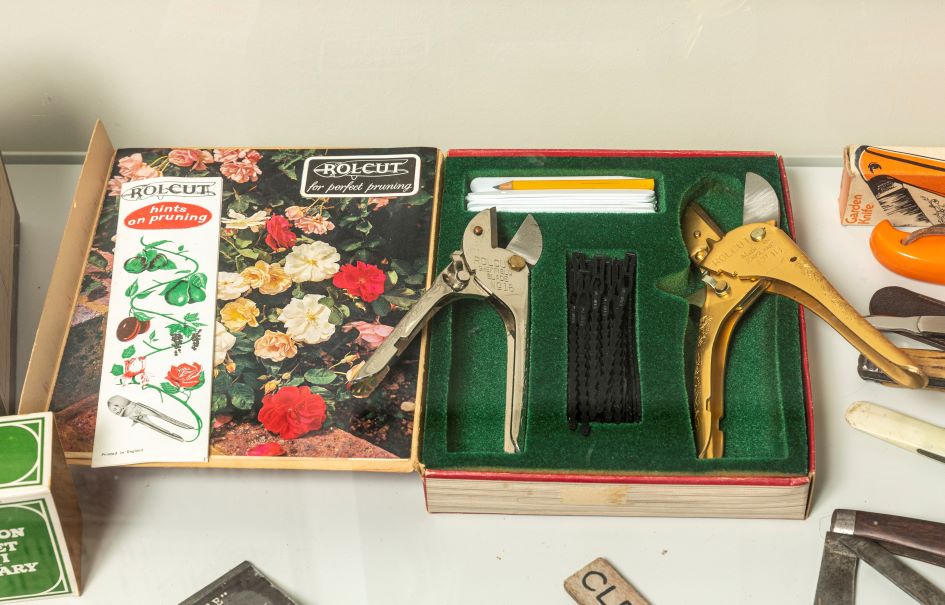
Secateurs
This set contains two pairs of Rolcut secateurs, plant ties, plant labels, pencils and leaflets. They were sold by Suttons Seeds Ltd. In Reading. Rolcut was a well known brand in the UK the tool design was from a German company called Löwe who had patented the first anvil pruner in 1923. The all metal design and anvil blade made them the toughest pruner available and they were the choice of many professionals and enthusiasts.
In 1928 came the invention of the Original LÖWE pruning shear under the “Rolcut” brand in England by Colonel B.J. Walker. In 1933 came the foundation of the company “Fritz Howaldt Ltd.” in London where in 1945 Rolcut took over the manufacture.
MERL 2010/71
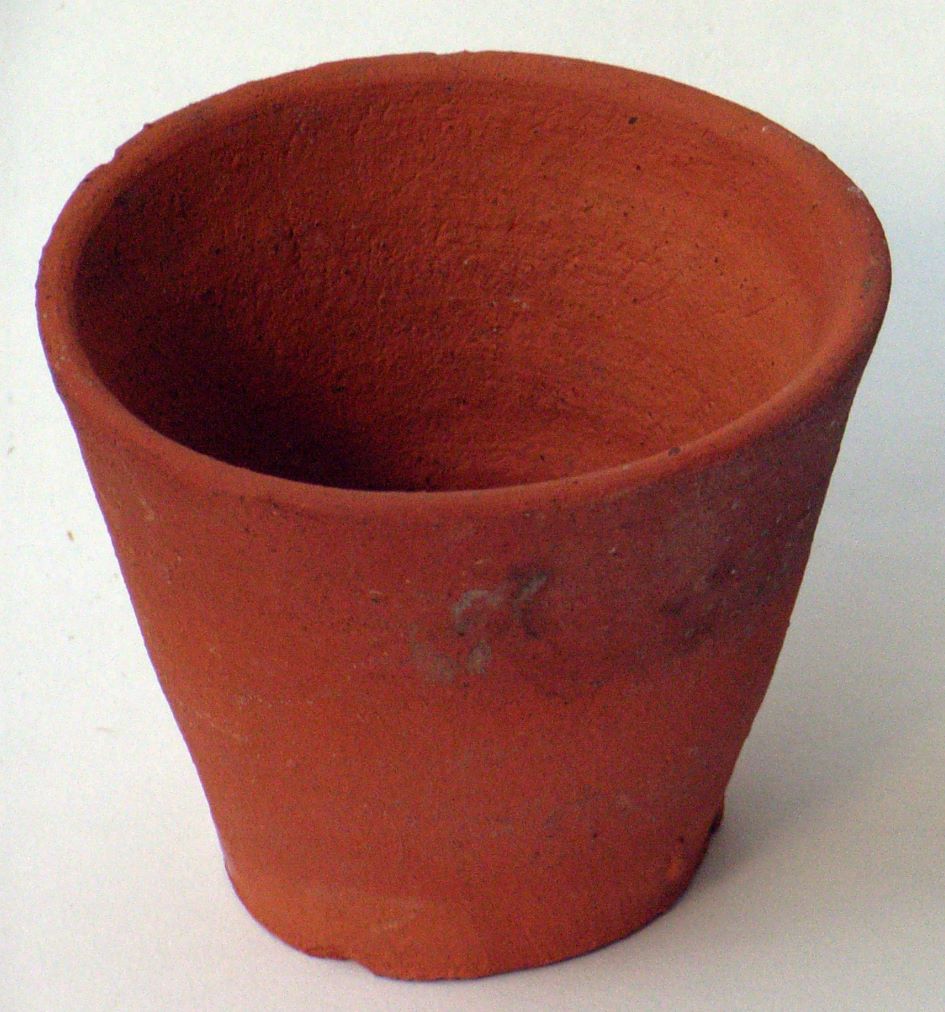
Plant Pots
These three handmade clay pots, of different sizes, were made at Tilehurst Potteries in Kentwood Hill, Reading, specialists in handmade tiles and flower pots. They are dated 1903 within a printing proof book, archive reference TR RAN P8/2. Mr Anostalgia acquired the block from his father – a blacksmith called Elliot from Londonderry. His father acquired the block during a visit to Ransomes.
Egyptians first used the flower pot to move plants from one location to another. The Romans used pots to bring plants inside during the winter. In Athens, earthenware flowerpots were thrown into the sea during the festival of the Gardens of Adonis.
MERL 2006/18/1-3
Rural Vogue Display

Rural Vogue Display
Land Rover
Jacket
Glastonbury Programme
Toy Tractor
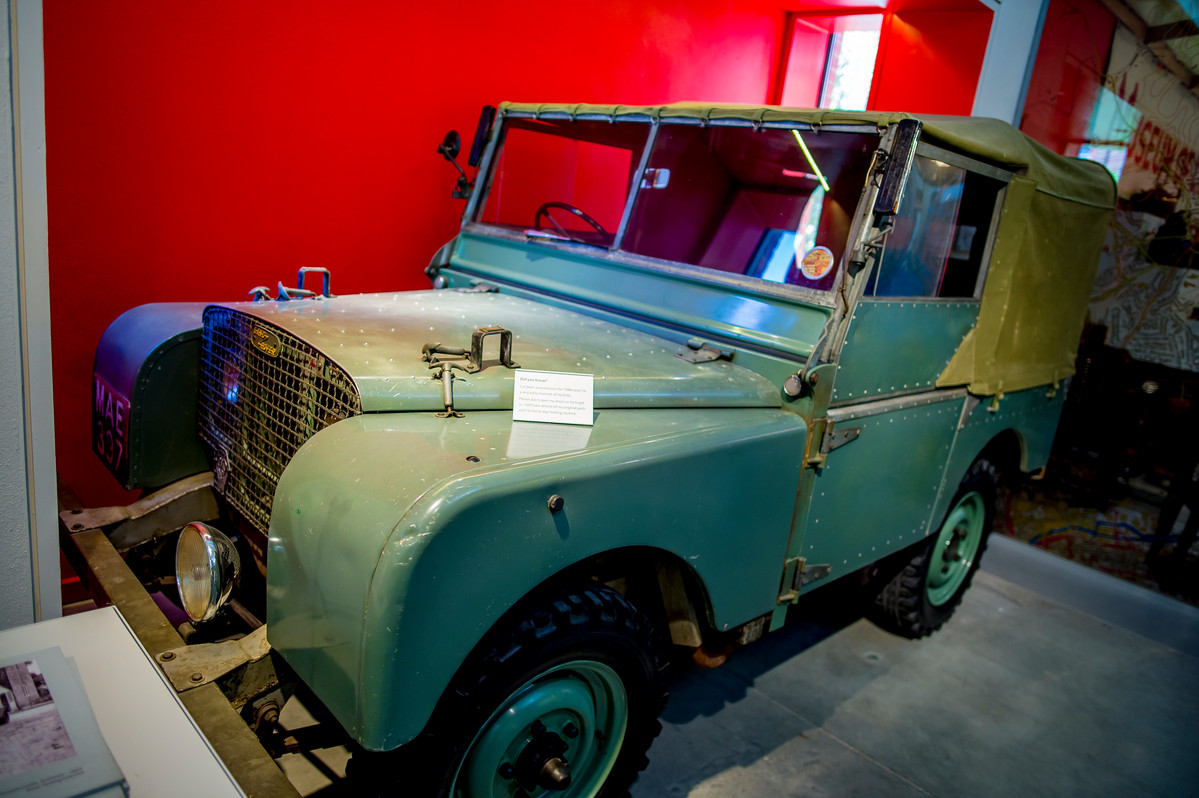
Land Rover
This is a Land Rover Series 1, produced by the Rover company in 1948, which quickly became a staple for farmers. Its ‘no frills’ design made it perfect for transporting tools, animals and other day-to-day tasks all while managing the rural landscape in varying weather.
It was owned since 1949 by Ivor Norris, a farmer from Avonmouth, Bristol. He used it on his farm until the late 1970s. On donation, the car came with it’s original log book, purchase receipt and most of its tax discs.
MERL 2013/1
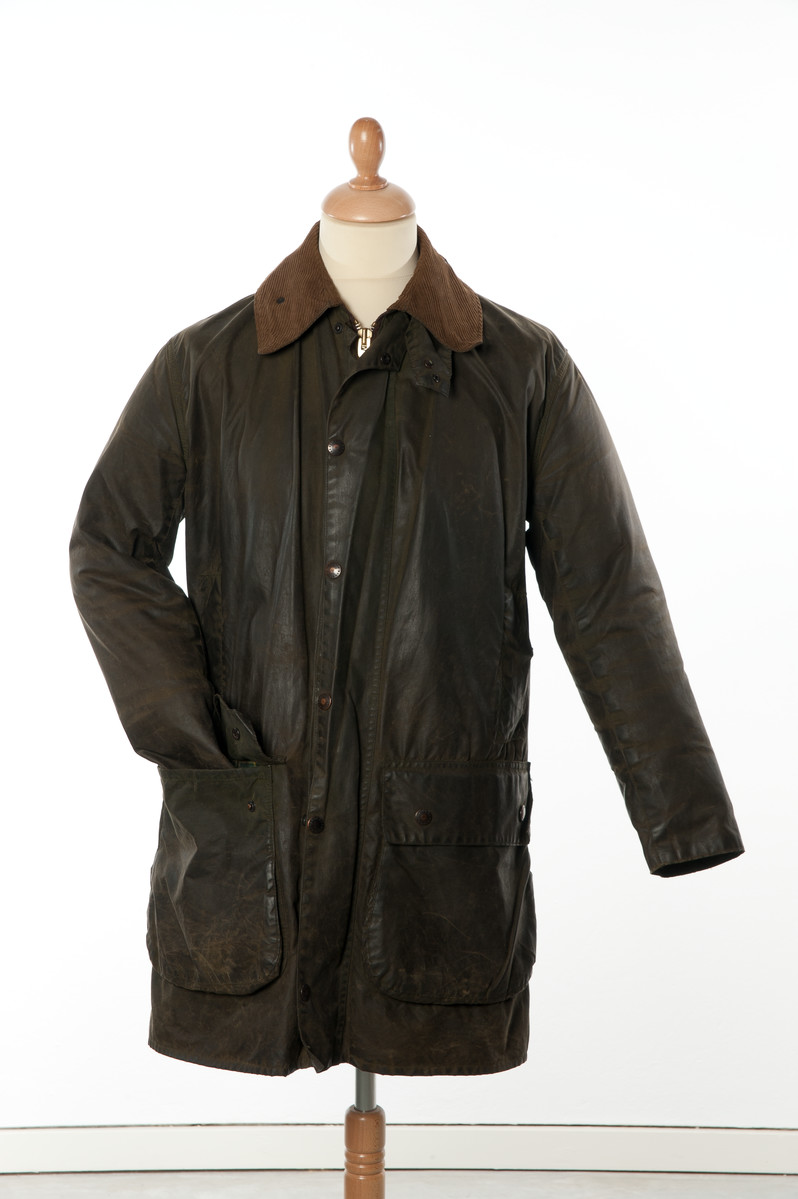
Jacket
Barbour Jackets began in 1894 in South Shields under the leadership of John Barbour, a draper with a farming background. Workwear was a speciality including oilskins for fishermen, shipbuilders and farmers of the area. This jacket dates from the 1982-87 (based on the Royal warrants), a time when rural fashion became mainstream. Today you are likely to see trendy celebrities sporting a Barbour jacket at Glastonbury.
MERL 2009/2
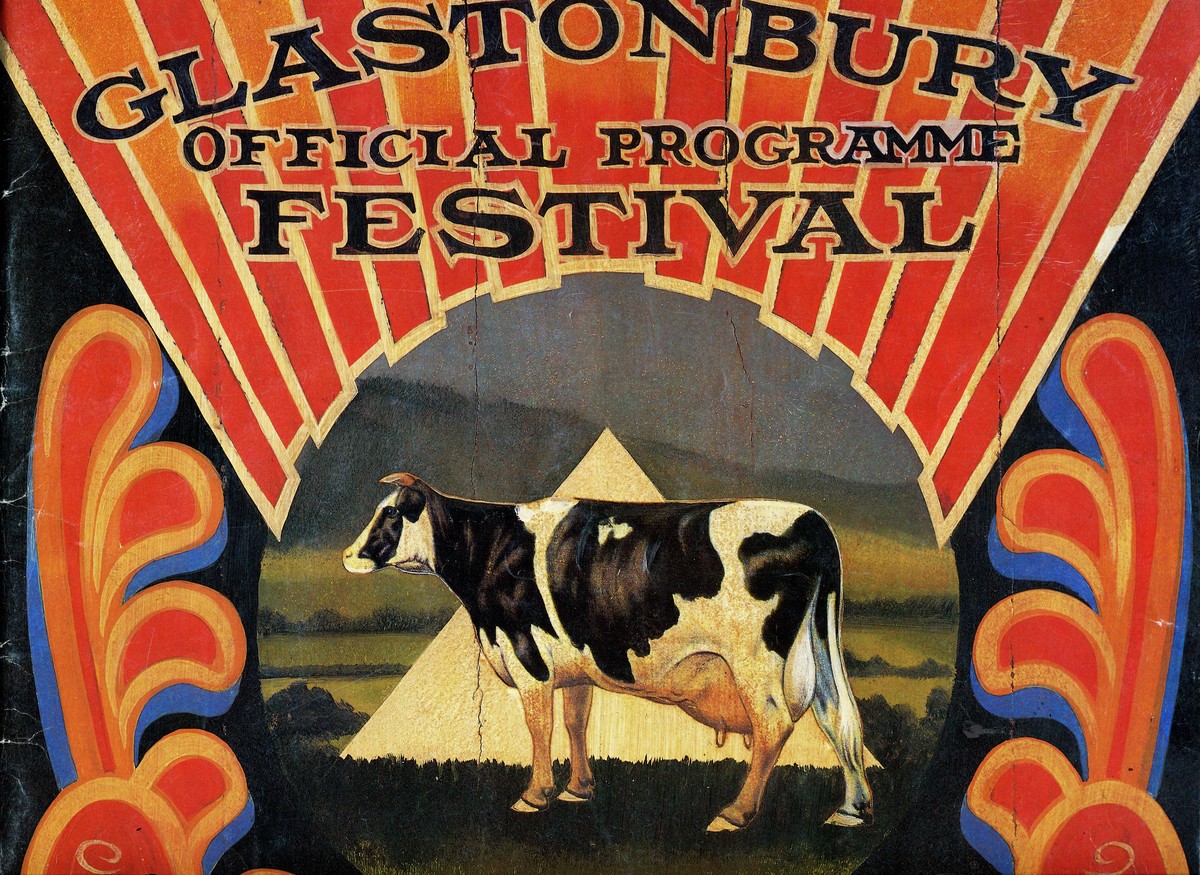
Glastonbury Programme
This is an official programme for the 1989 Glastonbury Festival of Contemporary Performing Arts. The festival ran from June 16-18 1989, in very good weather, and was attended by c.65,000 people. £100,000 was raised for CND (Campaign for Nuclear Disarmament) that year, and acts included Van Morrison and Elvis Costello.
Regarded as a major event in British culture, the festival is inspired by the ethos of the hippie, counterculture, and free festival movements. Michael Eavis hosted the first festival, then called Pilton Festival, after seeing an open-air Led Zeppelin concert at the 1970 Bath Festival of Blues and Progressive Music. The festival’s record crowd is 300,000 people, set at the 1994 festival, when headliners the Levellers performed a set on The Pyramid Stage. Recent stars have included Beyonce, Dolly Parton and Adele.
MERL 2009/42
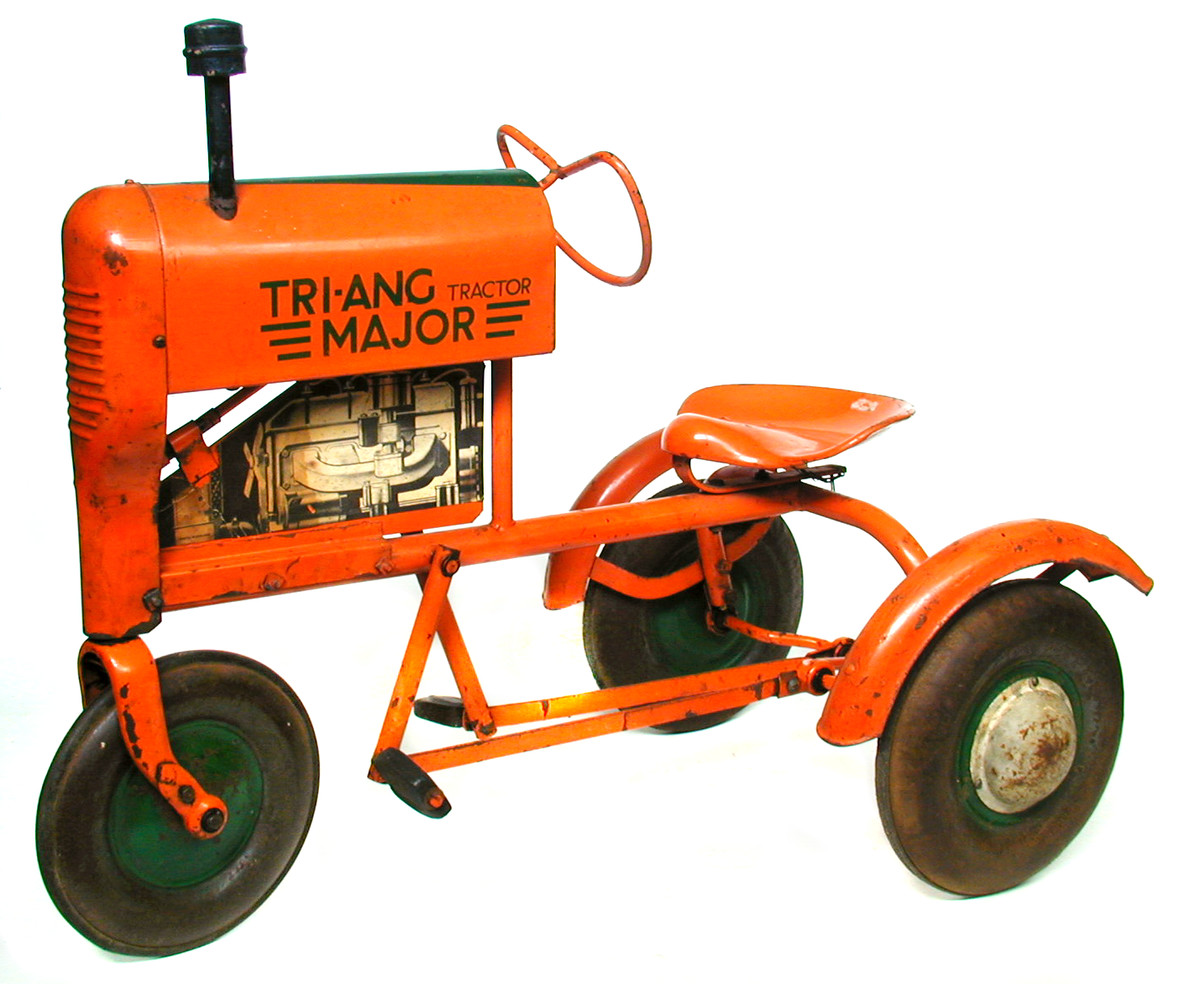
Toy Tractor
This tractor was made by the toy company Tri-ang. The title ‘Major’ echoed the famous Fordson of the same name. It was given as a birthday present in the 1950s to the donor for his 4th or 5th birthday.
Lines Bros Ltd, at its peak in 1947, was claimed by the company to be the largest toy maker in the world. Under the Tri-ang Toys brand name, Lines Bros Ltd also made children’s bicycles, such as the Unity Dragster TT. During the Second World War, Tri-ang factories were used to make the Sten MK III submachine gun.
MERL 93/91